Recent Advances and Perspectives of Carbon-Based Nanostructures as Anode Materials for Li-ion Batteries
Abstract
1. Introduction
1.1. Industrial Use of Lithium-Ion Battery Technology
1.2. Working Principles of Li-Ion Batteries
1.3. Utilization of Nanomaterials for Li-Ion Batteries
1.4. Advantages of Nanomaterials for Li-Ion Batteries
1.5. Disadvantages of Nanomaterials for Li-Ion Batteries
1.5.1. Comparison of Bulk and Nanomaterials for LIBs
1.6. Challenges for the Utilization of Nanomaterials for Li-Ion Batteries
2. Carbon-Based Nanostructures as Anode Materials for Li-Ion batteries
2.1. Carbonaceous Materials as Anode Materials for Li-Ion Batteries
2.2. Carbon Nanotubes (CNTs) as Anode Materials for Li-Ion Batteries
2.3. Carbon Nanofibers as Anode Materials for Li-Ion Batteries
2.4. Carbon Xerogel as Anode Materials for Li-Ion Batteries
2.5. Carbon Nanosprings as Anode Materials for Li-Ion Batteries
2.6. Graphene-Based Nanocomposite Anodes for Li-Ion Batteries
3. Conclusions and Future Directions
Author Contributions
Acknowledgments
Conflicts of Interest
References
- Ahmed, S.; Islam, M.T.; Karim, M.A.; Karim, N.M. Exploitation of renewable energy for sustainable development and overcoming power crisis in Bangladesh. Renew. Energy 2014, 72, 223–235. [Google Scholar] [CrossRef]
- Perera, F. Pollution from Fossil-Fuel Combustion is the Leading Environmental Threat to Global Pediatric Health and Equity: Solutions Exist. Int. J. Environ. Res. Public Health 2018, 15, 16. [Google Scholar] [CrossRef] [PubMed]
- Evangelos Kalamaras, M.; Maroto-Valer, M.; Shao, M.; Xuan, J.; Wang, H. Solar carbon fuel via photoelectrochemistry. Catal. Today 2018, 317, 56–75. [Google Scholar] [CrossRef]
- Chen, H.; Cong, T.N.; Yang, W.; Tan, C.; Li, Y.; Ding, Y. Progress in electrical energy storage system: A critical review. Prog. Nat. Sci. 2009, 19, 291–312. [Google Scholar] [CrossRef]
- Wu, Y.; Holze, R. Electrocatalysis at Electrodes for Vanadium Redox Flow Batteries. Batteries 2018, 4, 47. [Google Scholar] [CrossRef]
- Hesse, H.C.; Schimpe, M.; Kucevic, D.; Jossen, A. Lithium-Ion Battery Storage for the Grid—A Review of Stationary Battery Storage System Design Tailored for Applications in Modern Power Grids. Energies 2017, 10, 2107. [Google Scholar] [CrossRef]
- Shukla, A.K.; Kumar, T.P. Materials for next-generation lithium batteries. Curr. Sci. 2008, 94, 314–331. [Google Scholar]
- Liu, C.; Neale, Z.G.; Cao, G. Understanding electrochemical potentials of cathode materials in rechargeable batteries. Mater. Today 2016, 19, 109–123. [Google Scholar] [CrossRef]
- Chen, L.; Gu, Q.; Zhou, X.; Lee, S.; Xia, Y.; Liu, Z. New-concept Batteries Based on Aqueous Li1/Na1 Mixed-ion Electrolytes. Sci. Rep. 2013, 3, 1–7. [Google Scholar] [CrossRef]
- Fish, R.M.; Geddes, L.A. Conduction of Electrical Current to and Through the Human Body: A Review. ePlasty 2009, 9, 407–421. [Google Scholar]
- Hiremath, M.; Derendorf, K.; Vogt, T. Comparative Life Cycle Assessment of Battery Storage Systems for Stationary Applications. Environ. Sci. Technol. 2015, 49, 4825–4833. [Google Scholar] [CrossRef]
- Chu, Y.S.; Lister, T.E.; Cullen, W.G.; You, H.; Nagy, Z. Commensurate water monolayer at theRuO2(110)/water interface. Phys. Rev. Lett. 2001, 86, 3364–3367. [Google Scholar] [CrossRef]
- Dondelinger, R.M. Batteries: From alkaline to zinc-air. Biomed. Instrum. Technol. 2004, 38, 100–110. [Google Scholar]
- Wruck, W.J.; Reichman, B.; Bullock, K.R.; Kao, W.-H. Rechargeable Zn-Mn02 Alkaline Batteries. J. Electrochem. Soc. 1991, 138, 3560–3567. [Google Scholar] [CrossRef]
- Gaines, L. The future of automotive lithium-ion battery recycling: Charting a sustainable course. Sustain. Mater. Technol. 2014, 1–2, 2–7. [Google Scholar] [CrossRef]
- Garche, J. Advanced battery systems—The end of the lead–acid battery? Phys. Chem. Chem. Phys. 2001, 3, 356–367. [Google Scholar] [CrossRef]
- Nowak, S.; Winter, M. The Role of Cations on the Performance of Lithium Ion Batteries: A Quantitative Analytical Approach. Acc Chem. Res. 2018, 51, 265–272. [Google Scholar] [CrossRef]
- Manthiram, A.; Fu, Y.; Chung, S.-H.; Zu, C.; Su, Y.-S. Rechargeable Lithium-Sulfur Batteries. Chem. Rev. 2014, 114, 11751–11787. [Google Scholar] [CrossRef]
- Xu, W.; Wang, J.; Ding, F.; Chen, X.; Nasybulin, E.; Zhang, Y.; Zhang, J.-G. Lithium metal anodes for rechargeable batteries. Energy Environ. Sci. 2014, 7, 513–537. [Google Scholar] [CrossRef]
- Lee, J.-S.; Cao, S.T.K.R.; Choi, N.-S.; Liu, M.; Lee, K.T.; Cho, J. Metal–Air Batteries with High Energy Density: Li-Air versus Zn–Air. Adv. Energy Mater. 2011, 1, 34–50. [Google Scholar] [CrossRef]
- Bauman, H.G.; Chilton, J.E.; Cook, G.M. New Cathode-Anode Couples using Nonaqueous Electrolyte; Lockheed Missiles and Space Co., Inc.: Palo Alto, CA, USA, 1963. [Google Scholar]
- Tarascon, J.M.; Armand, M. Issues and challenges facing rechargeable lithium batteries. Nature 2001, 414, 359–367. [Google Scholar] [CrossRef]
- Ohzuku, T.; Ueda, A.; Nagayama, M. Electrochemistry and structural chemistry of LiNiO2 (R3m) for 4 Volt secondary lithium cells. J. Electrochem. Soc. 1993, 140, 1862–1870. [Google Scholar] [CrossRef]
- Zhuravlev, V.D.; PachuevK, A.V.; NefedovaL, V.; Ermakova, V. Solution-Combustion Synthesis of LiNi1/3Co1/3Mn1/3O2 as a Cathode Material for Lithium-Ion Batteries. Int. J. Self-Propag. High-Temp. Synth. 2018, 27, 154–161. [Google Scholar] [CrossRef]
- Blomgren, G.E. The Development and Future of Lithium Ion Batteries. J. Electrochem. Soc. 2017, 164, A5019–A5025. [Google Scholar] [CrossRef]
- Zelinsky, M.A.; Koch, J.M.; Young, K.-H. Performance Comparison of Rechargeable Batteries for Stationary Applications (Ni/MH vs. Ni-Cd and VRLA). Batteries 2018, 4, 1. [Google Scholar] [CrossRef]
- Bernard, P.; Lippert, M. Nickel–Cadmium and Nickel–Metal Hydride Battery Energy Storage. Electrochem. Energy Storage Renew. Sources Grid Balanc. 2015, 223–251. [Google Scholar] [CrossRef]
- MacLean, G.K.; Aiken, P.A.; Adams, W.A.; Mussivand, T. Comparison of rechargeable lithium and nickel/cadmium battery cells for implantable circulatory support devices. Artif. Organs 1994, 18, 331–334. [Google Scholar] [CrossRef]
- Shen, W.X.; Chan, C.C.; Lo, E.W.C.; Chau, K.T. Estimation of battery available capacity under variable discharge currents. J. Power Sources 2002, 103, 180–187. [Google Scholar] [CrossRef]
- Sukhvinder, P.; Badwal, S.; Giddey, S.S.; Munnings, C.; Bhatt, A.I.; Hollenkamp, A.F. Emerging electrochemical energy conversion and storage technologies. Front. Chem. 2014, 2, 1–28. [Google Scholar] [CrossRef]
- Gao, J.; Shi, S.-Q.; Li, H. Brief overview of electrochemical potential in lithium ion batteries. Chin. Phys. B 2016, 25, 018210. [Google Scholar] [CrossRef]
- Girishkumar, G.; McCloskey, B.; Luntz, A.C.; Swanson, S.; Wilcke, W. Lithium-Air Battery: Promise and Challenges. J. Phys. Chem. Lett. 2010, 1, 2193–2203. [Google Scholar] [CrossRef]
- Wu, Y.P.; Rahm, E.; Holze, R. Carbon Anode Materials for Lithium Ion Batteries. J. Power Sources 2003, 114, 228–236. [Google Scholar] [CrossRef]
- Wang, Y.; He, P.; Zhou, H. A lithium–air capacitor–battery based on a hybrid electrolyte. Energy Environ. Sci. 2011, 4, 4994–4999. [Google Scholar] [CrossRef]
- Xu, K. Nonaqueous Liquid Electrolytes for Lithium-Based Rechargeable Batteries. Chem. Rev. 2004, 104, 4303–4417. [Google Scholar] [CrossRef]
- Malik, R.; Burch, D.; Bazant, M.; Ceder, G. Particle size dependence of the ionic diffusivity. Nano Lett. 2010, 10, 4123–4127. [Google Scholar] [CrossRef]
- Poizot, P.; Laruelle, S.; Grugeon, S.; Dupont, L.; Tarascon, J.M. Nanosized transition-metal oxides as negative-electrode materials for lithium-ion batteries. Nature 2000, 407, 496–499. [Google Scholar] [CrossRef]
- Bekaert, E.; Balaya, P.; Murugavel, S.; Maier, J.; Ménétrier, M. 6Li MAS NMR investigation of electrochemical lithiation of RuO2: Evidence for an interfacial storage mechanism. Chem. Mater. 2009, 21, 856–861. [Google Scholar] [CrossRef]
- Chandler, J.H.; Head, D.A.; Hubbard, M.E.; Neville, A.; Jayne, D.G.; Culmer, P.R. The impact of electrode resistance on the biogalvanic characterization technique. Physiol. Meas. 2017, 38, 101–115. [Google Scholar] [CrossRef]
- Evans, J.W. Introduction and the Significance of Electrometallurgy. Ref. Module Mater. Sci. Mater. Eng. 2016, 1–13. [Google Scholar] [CrossRef]
- da Silva, S.P.; da Silva, P.R.C. Alexandre Urbano e Jair Scarminio, Analysis of A Commercial Portable Lithium-Ion Battery Under Low Current Charge–discharge Cycles, Quim. Nova 2016, 39, 901–905. [Google Scholar] [CrossRef]
- Zhang, H.; Zhao, H.; Khan, M.A.; Zou, W.; Xu, J.; Zhang, L.; Zhang, J. Recent progress in advanced electrode materials, separators and electrolytes for lithium batteries. J. Mater. Chem. A 2018, 6, 20564–20620. [Google Scholar] [CrossRef]
- He, Y.; Matthews, B.; Wang, J.; Song, L.; Wang, X.; Wu, G. Innovation and challenges in materials design for flexible rechargeable batteries: From 1D to 3D. J. Mater. Chem. A 2018, 6, 735–753. [Google Scholar] [CrossRef]
- Nitta, N.; Wu, F.; Lee, J.T.; Yushin, G. Li-ion battery materials: Present and future. Mater. Today 2015, 18, 252–264. [Google Scholar] [CrossRef]
- Galushkin, N.E.; Yazvinskaya, N.N.; Galushkin, D.N. Mechanism of thermal runaway in lithium-ion cells. J. Electrochem. Soc. 2018, 165, A1303–A1308. [Google Scholar] [CrossRef]
- Cabana, J.; Valdés-Solís, T.; Palacín, M.R.; Oró-Solé, J.; Fuertes, A.; Marbán, G.; Fuertes, A.B. Enhanced high rate performance of LiMn2O4 spinel nanoparticles synthesized by a hard-template route. J. Power Sources 2007, 166, 492–498. [Google Scholar] [CrossRef]
- Jiang, C.; Hosono, E.; Zhou, H. Nanomaterials for lithium ion batteries. Nano Today 2006, 1, 28–33. [Google Scholar] [CrossRef]
- Liu, X.H.; Zhong, L.; Huang, S.; Mao, S.X.; Zhu, T.; Huang, J.Y. Size-Dependent Fracture of Silicon Nanoparticles During Lithiation. ACS Nano 2012, 6, 1522–1531. [Google Scholar] [CrossRef]
- Sankarasubramanian, S.; Krishnamurthy, B. A capacity fade model for lithium ion batteries including diffusion and kinetics. Electrochim. Acta 2012, 70, 248–254. [Google Scholar] [CrossRef]
- Lüder, J.; Legrain, F.; Chen, Y.; Manzhos, S. Doping of active electrode materials for electrochemical batteries: An electronic structure perspective. MRS Commun. 2017, 7, 523–540. [Google Scholar] [CrossRef]
- Wang, Y.; Li, H.; He, P. Eiji Hosonoa and Haoshen Zhou, Nano active materials for lithium-ion batteries. Nanoscale 2010, 2, 1294–1305. [Google Scholar] [CrossRef]
- Wang, X.; Liu, D.; Weng, Q.; Liu, J.; Liang, Q.; Zhang, C. Cu/Li4Ti5O12 scaffolds as superior anodes for lithium-ion batteries. NPG Asia Mater. 2015, 7, 1–7. [Google Scholar] [CrossRef]
- Courtel, F.M.; Duncan, H.; Abu-Lebdeh, Y.; Davidson, I.J. High capacity anode materials for Li-ion batteries based on spinel metal oxides AMn2O4 (A = Co, Ni, and Zn). J. Mater. Chem. 2011, 21, 10206–10218. [Google Scholar] [CrossRef]
- Khalajhedayati, A.; Pan, Z.; Rupert, T.J. Manipulating the interfacial structure of nanomaterials to achieve a unique combination of strength and ductility. Nat. Commun. 2016, 7, 1–8. [Google Scholar] [CrossRef]
- Zhang, H.; Mao, C.; Li, J.; Chen, R. Advances in electrode materials for Li-based rechargeable batteries. RSC Adv. 2017, 7, 33789–33811. [Google Scholar] [CrossRef]
- Yu, Z.; Tetard, L.; Zhai, L.; Thomas, J. Supercapacitor electrode materials: Nanostructures from 0 to 3 dimensions. Energy Environ. Sci. 2015, 8, 702–730. [Google Scholar] [CrossRef]
- Okubo, M.; Hosono, E.; Kim, J.; Enomoto, M.; Kojima, N.; Kudo, T.; Zhou, H.; Honma, I. Nanosize effect on high-rate Li-ion intercalation in LiCoO2 electrode. J. Am. Chem. Soc. 2007, 129, 7444–7452. [Google Scholar] [CrossRef]
- Uchlyama, H.; Hosono, E.; Honma, I.; Zhou, H.; Imai, H. A nanoscale meshed electrode of single-crystalline SnO for lithium-ion rechargeable batteries. Electrochem. Commun. 2008, 10, 52–55. [Google Scholar] [CrossRef]
- Robertson, A.D.; Robert Armstrong, A.; Bruce, P.G. Layered LixMn1-yCoyO2 intercalation electrodes influence of ion exchange on capacity and structure upon cycling. Chem. Mater. 2001, 13, 2380–2386. [Google Scholar] [CrossRef]
- Fan, Y.; Zhang, Q.; Xiao, Q.; Wang, X.; Huang, K. High-performance lithium ion battery anodes based on carbon nanotube-silicon core–shell nanowires with controlled morphology. Carbon 2013, 59, 264–269. [Google Scholar] [CrossRef]
- Cheng, L.; Liu, H.J.; Zhang, J.J.; Xiong, H.M.; Xia, Y.Y. Nanosized Li4Ti5O12 Prepared by Molten Salt Method as an Electrode Material for Hybrid Electrochemical Supercapacitors. J. Electrochem. Soc. 2006, 153, A1472–A1477. [Google Scholar] [CrossRef]
- Zukalova, M.; Prochazka, J.; Zukal, A.; Yum, J.H.; Kavan, L.; Graetzel, M. Organized Mesoporous TiO2 Films Stabilized by Phosphorus: Application for Dye-Sensitized Solar Cells. J. Electrochem. Soc. 2010, 157, H99–H103. [Google Scholar] [CrossRef]
- Guo, Y.G.; Hu, J.S.; Wan, L.J. Nanostructured Materials for Electrochemical Energy Conversion and Storage Devices. Adv. Mater. 2008, 20, 2878. [Google Scholar] [CrossRef]
- Liu, N.; Lu, Z.; Zhao, J.; McDowell, M.T.; Lee, H.-W.; Zhao, W.; Cui, Y. A pomegranate-inspired nanoscale design for large-volume-change lithium battery anodes. Nat. Nanotech. 2014, 9, 187–192. [Google Scholar] [CrossRef] [PubMed]
- Nagamine, K.; Oh-Ishi, K.; Honma, T.; Komatsu, T. Formation mechanism of LiFePO4 in crystallization of lithium iron phosphate glass particles. J. Ceram. Soc. Jpn. 2012, 120, 193–198. [Google Scholar] [CrossRef]
- Sun, Y.K.; Chen, Z.; Noh, H.-J.; Lee, D.-J.; Jung, H.-G.; Ren, Y.; Wang, S.; Yoon, C.S.; Myung, S.-T.; Amine, K. Nanostructured high-energy cathode materials for advanced lithium batteries. Nat. Mater. 2012, 11, 942–947. [Google Scholar] [CrossRef] [PubMed]
- Oh, S.W.; Myung, S.; Oh, S.; Oh, K.H.; Amine, K.; Scrosati, B.; Sun, Y. Double carbon coating of LiFePO4 as high rate electrode for rechargeable lithium batteries. Adv. Mater. 2010, 22, 4842–4845. [Google Scholar] [CrossRef] [PubMed]
- Lin, D.; Lu, Z.; Hsu, P.-C.; Lee, H.R.; Liu, N.; Zhao, J.; Wang, H.; Liu, C.; Cui, Y. A high tap density secondary silicon particle anode fabricated by scalable mechanical pressing for lithium-ion batteries. Energy Environ. Sci. 2015, 8, 2371–2376. [Google Scholar] [CrossRef]
- Choi, N.S.; Chen, Z.; Freunberger, S.A.; Ji, X.; Sun, Y.K.; Amine, K.; Yushin, G.; Nazar, L.F.; Cho, J.; Bruce, P.G. Challenges facing lithium batteries and electrical double-layer capacitors. Angew. Chem. Int. Ed. Engl. 2012, 51, 9994–10024. [Google Scholar] [CrossRef]
- Zhao, Y.; Wang, L.P.; Sougrati, M.T.; Feng, Z.; Leconte, Y.; Fisher, A.; Srinivasan, M.; Xu, Z. A Review on Design Strategies for Carbon Based Metal Oxides and Sulfides Nanocomposites for High Performance Li and Na Ion Battery Anodes. Adv. Energy Mater. 2017, 1601424. [Google Scholar] [CrossRef]
- Yazami, R.; Touzain, P. A reversible graphite-lithium negative electrode for electrochemical generators. J. Power Sources 1983, 9, 365–371. [Google Scholar] [CrossRef]
- Brandt, K. Historical development of secondary lithium batteries. Solid State Ionics 1994, 69, 173–183. [Google Scholar] [CrossRef]
- Iijima, S. Helical microtubules of graphitic carbon. Nature 1991, 354, 56–58. [Google Scholar] [CrossRef]
- Hassoun, J.; Bonaccorso, F.; Agostini, M.; Angelucci, M.; Betti, M.G.; Cingolani, R.; Scrosati, B. An advanced lithium-ion battery based on a graphene anode and a lithium iron phosphate cathode. Nano Lett. 2014, 14, 4901–4906. [Google Scholar] [CrossRef]
- Faraji, S.; Yildiz, O.; Rost, C.; Stano, K.; Farahbakhsh, N.; Zhu, Y.; Bradford, P.D. Radial growth of multi-walled carbon nanotubes in aligned sheets through cyclic carbon deposition and graphitization. Carbon 2017, 111, 411–418. [Google Scholar] [CrossRef]
- Zhao, J.; Wei, L.; Yang, Z.; Zhang, Y. Continuous and low-cost synthesis of high-quality multi-walled carbon nanotubes by arc discharge in air. Phys. E Low-Dimens. Syst. Nanostruct. 2012, 44, 1639–1643. [Google Scholar] [CrossRef]
- Faraji, S.; Stano, K.; Rost, C.; Maria, J.P.; Zhu, Y.; Bradford, P.D. Structural annealing of carbon coated aligned multi-walled carbon nanotube sheets. Carbon 2014, 79, 113–122. [Google Scholar] [CrossRef]
- Nakayama, A.; Numao, S.; Nakano, S.; Bandow, S.; Iijima, S. In-situ observation of structural change in MWCNTs under high-pressure H2 gas atmosphere. Diam. Relat. Mater. 2008, 17, 548–551. [Google Scholar] [CrossRef]
- Bachtold, A.; Strunk, C.; Salvetat, J.P.; Bonard, J.M.; Forró, L.; Nussbaumer, T.; Schönenberger, C. Aharonov–Bohm oscillations in carbon nanotubes. Nature 1999, 397, 673–675. [Google Scholar] [CrossRef]
- Koh, W.; Choi, J.I.; Donaher, K.; Lee, S.G.; Jang, S.S. Mechanism of Li adsorption on carbon nanotube-fullerene hybrid system: A first-principles study. ACS Appl. Mater. Interfaces 2011, 3, 1186–1194. [Google Scholar] [CrossRef]
- Shen, J.M.; Xu, L.; Liu, Y.G.; Lu, C.L.; Hou, W.H.; Zhu, J.J. Wet chemistry self-seeded surface-deposition process toward amorphous carbon nanotubes and their electrochemical application. Chem. Mater. 2008, 20, 3034–3041. [Google Scholar] [CrossRef]
- Zhou, J.; Song, H.; Fu, B.; Wu, B.; Chen, X. Synthesis and high-rate capability of quadrangular carbon nanotubes with one open end as anode materials for lithium-ion batteries. J. Mater. Chem. 2010, 20, 2794–2800. [Google Scholar] [CrossRef]
- Chen, J.; Zhao, J.; Minett, A.; Liu, Y.; Crean, C.; Liu, H.K.; Wallace, G. Carbon nanotube network modified carbon fiber paper for Li-ion batteries. Energy Environ. Sci. 2009, 2, 393–396. [Google Scholar] [CrossRef]
- Leitner, K.; Lerf, A.; Winter, M.; Besenhard, J.O.; Villar-Rodil, S.; Suárez-García, F.; Martínez-Alonso, A.; Tascón, J.M.D. Nomex-derived activated carbon fibers as electrode materials in carbon-based supercapacitors. J. Power Sources 2006, 153, 419–423. [Google Scholar] [CrossRef]
- Nga, S.H.; Wang, J.; Guo, Z.P.; Chen, J.; Wang, G.X.; Liu, H.K. Single wall carbon nanotube paper as anode for lithium-ion battery. Electrochim. Acta 2005, 51, 23–28. [Google Scholar] [CrossRef]
- Wang, Y.; Wu, M.; Jiao, Z.; Lee, J.Y. Sn@CNT and Sn@C@CNT nanostructures for superior reversible lithium ion storage. Chem. Mater. 2009, 21, 3210–3215. [Google Scholar] [CrossRef]
- Maurin, G.; Bousquet, C.; Henn, F.; Bernier, P.; Almairac, R.; Simon, B. Electrochemical intercalation of lithium into multiwalledcarbon nanotubes. Chem. Phys. Lett. 1999, 312, 14–18. [Google Scholar] [CrossRef]
- Maurin, G.; Bousquet, C.; Henn, F.; Bernier, P.; Almairac, R.; Simon, B. Electrochemical lithium interrelation into multiwalledcarbon nanotubes. Solid State Ionics 2000, 136–137, 1295–1299. [Google Scholar] [CrossRef]
- Gao, B.; Kleinhammes, A.; Tang, X.P.; Bower, C.; Fleming, L.; Wu, Y.; Zhou, O. Electrochemical intercalation of single-walled carbon nanotubes with lithium. Chem. Phys. Lett. 1999, 307, 153–157. [Google Scholar] [CrossRef]
- Leroux, F.; Méténier, K.; Gautier, S.; Frackowiak, E.; Bonnamy, S.; Béguin, F. Electrochemical insertion of lithium in catalytic multiwalled carbon nanotubes. J. Power Sources 1999, 81–82, 317–322. [Google Scholar] [CrossRef]
- Yang, Z.; Wu, H.Q.; Simard, B. Charge–discharge characteristics of raw acid-oxidized carbon nanotubes. Electrochem. Commun. 2002, 4, 574–578. [Google Scholar] [CrossRef]
- Pierard, N.; Fonseca, A.; Konya, Z.; Willems, I.; van Tendeloo, G.; Nagy, J.B. Production of short carbon nanotubes with open tips by ball milling. Chem. Phys. Lett. 2001, 335, 1–8. [Google Scholar] [CrossRef]
- Xing, W.; Dunlap, R.; Dahn, J. Studies of lithium insertion in ball milled sugar carbons. J. Electrochem. Soc. 1998, 145, 62–70. [Google Scholar] [CrossRef]
- Disma, F.; Aymard, L.; Dupont, L.; Tarascon, J. Effect of mechanical grinding on the lithium intercalation process in graphites and soft carbons. J. Electrochem. Soc. 1996, 143, 3959–3972. [Google Scholar] [CrossRef]
- Frackowiak, E.; Gautier, S.; Gaucher, H.; Bonnamy, S.; Beguin, F. Electrochemical storage of lithium multiwalled carbon nanotubes. Carbon 1999, 37, 61–69. [Google Scholar] [CrossRef]
- Li, M.; Wu, Y.; Zhao, F.; Wei, Y.; Wang, J.; Jiang, K.; Fan, S. Cycle and rate performance of chemically modified super-aligned carbon nanotube electrodes for lithium ion batteries. Carbon 2014, 69, 444–451. [Google Scholar] [CrossRef]
- Gao, B.; Bower, C.; Lorentzen, J.D.; Fleming, L.; Kleinhammes, A.; Tang, X.P.; McNeil, L.E.; Wu, Y.; Zhou, O. Enhanced saturation lithium composition in ball-milled single-walled carbon nanotubes. Chem. Phys. Lett. 2000, 327, 69–75. [Google Scholar] [CrossRef]
- Yang, S.; Huo, J.; Song, H.; Chen, X. A comparative study of electrochemical properties of two kinds of carbon nanotubes as anode materials for lithium ion batteries. Electrochim. Acta 2008, 53, 2238–2244. [Google Scholar] [CrossRef]
- Wang, X.X.; Wang, J.N.; Su, L.F. Preparation and electrochemical performance of ultra-short carbon nanotubes. J. Power Sources 2009, 186, 194–200. [Google Scholar] [CrossRef]
- Mi, C.H.; Cao, G.S.; Zhao, X.B. A nonGIC mechanism of lithium storage in chemical etched MWNTs. J. Electroanal. Chem. 2004, 562, 217–221. [Google Scholar] [CrossRef]
- Eom, J.Y.; Kwon, H.S.; Liu, J.; Zhou, O. Lithium insertion into purified and etched multiwalled carbon nanotubes synthesized on supported catalysts by thermal CVD. Carbon 2004, 42, 2589–2596. [Google Scholar] [CrossRef]
- Maurin, G.; Henn, F.; Simon, B.; Colomer, J.F.; Nag, J.B. Lithium doping of multiwalled carbon nanotubes produced by catalytic decomposition. Nano Lett. 2001, 1, 75–79. [Google Scholar] [CrossRef]
- Li, X.; Gu, H.; Liu, J.; Wei, H.; Qiu, S.; Fu, Y.; Lv, H.; Lu, G.; Wang, Y.; Guo, Z. Multiwalled carbon nanotubes composited with nanomagnetite for anodes in lithium ion batteries. RSC Adv. 2015, 5, 7237–7244. [Google Scholar] [CrossRef]
- Yang, Z.H.; Wu, H.Q. Electrochemical intercalation of lithium into carbon nanotubes. Solid State Ionics 2001, 143, 173–180. [Google Scholar] [CrossRef]
- Yang, Z.H.; Wu, H.Q. Electrochemical intercalation of lithium into raw carbon nanotubes. Mater. Chem. Phys. 2001, 71, 7–11. [Google Scholar] [CrossRef]
- Wu, G.T.; Wang, C.S.; Zhang, X.B.; Yang, H.S.; Qi, Z.F.; He, P.M.; Li, W.Z. Structure and lithium insertion properties of carbon nanotubes. J. Electrochem. Soc. 1999, 146, 1696–1701. [Google Scholar] [CrossRef]
- Wu, G.T.; Wang, C.S.; Zhang, X.B.; Yang, H.S.; Qi, Z.F.; Li, W.Z. Lithium insertion into CuO/carbon nanotubes. J. Power Sources 1998, 75, 175–179. [Google Scholar] [CrossRef]
- Che, G.L.; Lakshmi, B.B.; Fisher, E.R.; Martin, C.R. Carbon nanotubule membranes for electrochemical energy storage and production. Nature 1998, 393, 346–349. [Google Scholar] [CrossRef]
- Mukhopadhyay, I.; Hoshino, N.; Kawasaki, S.; Okino, F.; Hsu, W.K.; Touhara, H. Electrochemical Li insertion in B-doped multiwalledcarbon nanotubes. J. Electrochem. Soc. 2002, 149, A39–A44. [Google Scholar] [CrossRef]
- Lee, R.S.; Kim, H.J.; Fischer, J.E.; Thess, A.; Smalley, R.E. Conductivity enhancement in single-walled carbon nanotube bundles doped with K and Br. Nature 1997, 388, 255–257. [Google Scholar] [CrossRef]
- Claye, A.; Fischer, J.E.; Metrot, A. Kinetics of alkali insertion in single-wall carbon nanotubes: An electrochemical impedance spectroscopy study. Chem. Phys. Lett. 2000, 330, 61–67. [Google Scholar] [CrossRef]
- Claye, A.; Rahman, S.; Fischer, J.E.; Sirenko, A.; Sumanasekera, G.U.; Eklund, P.C. In situ Raman scattering studies of alkali-doped single-wall carbon nanotubes. Chem. Phys. Lett. 2001, 333, 16–22. [Google Scholar] [CrossRef]
- Cao, K.; Jin, T.; Yang, L.; Jiao, L. Recent progress in conversion reaction metal oxide anodes for Li-ion batteries. Mater. Chem. Front. 2017, 1, 2213–2242. [Google Scholar] [CrossRef]
- Ko, S.; Lee, J.I.; Yang, H.S.; Park, S.; Jeong, U. Mesoporous CuO particles threaded with CNTs for high-performance lithium-ion battery anodes. Adv. Mater. 2012, 24, 4451–4456. [Google Scholar] [CrossRef]
- Yang, Z.; Li, Z.; Wu, H.; Simard, B. Effects of doped copper on electrochemical performance of the raw carbon nanotubes anode. Mater. Lett. 2003, 57, 3160–3166. [Google Scholar] [CrossRef]
- Winter, M.; Besenhard, J.O. Electrochemical lithiation of tin and tin-based intermetallics and composites. Electrochim. Acta 1999, 45, 31–50. [Google Scholar] [CrossRef]
- Chen, W.X.; Lee, J.Y.; Liu, Z. The nanocomposites of carbon nanotube with Sb and SnSb0.5 as Li-ion battery anodes. Carbon 2003, 41, 959–966. [Google Scholar] [CrossRef]
- Guo, Z.P.; Zhao, Z.W.; Liu, H.K.; Dou, S.X. Electrochemical lithiation and de-lithiation of MWNT–Sn/SnNi nanocomposites. Carbon 2005, 43, 1392–1399. [Google Scholar] [CrossRef]
- Eom, J.Y.; Park, J.W.; Kwon, H.S.; Rajendran, S. Electrochemical insertion of lithium into multiwalled carbon nanotube/silicon composites produced by ball milling. J. Electrochem. Soc. 2006, 153, A1678–A1684. [Google Scholar] [CrossRef]
- Xie, J.; Varadan, V.K. Synthesis and characterization of high surface area tin oxide/functionalized carbon nanotubes composite as anode materials. Mater. Chem. Phys. 2005, 91, 274–280. [Google Scholar] [CrossRef]
- Yang, S.; Song, H.; Yi, H.; Liu, W.; Zhang, H.; Chen, X. Carbon nanotube capsules encapsulating SnO2 nanoparticles as an anode material for lithium ion batteries. Electrochim. Acta 2009, 55, 521–527. [Google Scholar] [CrossRef]
- Shu, J.; Li, H.; Yang, R.Z.; Shi, Y.; Huang, X.J. Cage-like carbon nanotubes/Si composite as anode material for lithium ion batteries. Electrochem. Commun. 2006, 8, 51–54. [Google Scholar] [CrossRef]
- Dai, J.X.; Li, S.F.Y.; Siow, K.S.; Gao, Z.Q. Synthesis and characterization of the hollandite-type MnO2 as a cathode material in lithium batteries. Electrochim. Acta 2000, 45, 2211–2217. [Google Scholar] [CrossRef]
- Wu, M.S.; Chiang, P.C. Synthesis of manganese oxide electrodes with interconnected nanowire structure as an anode material for rechargeable lithium ion batteries. J. Phys. Chem. B 2005, 109, 23279–23284. [Google Scholar] [CrossRef] [PubMed]
- Jin, X.B.; Zhou, W.Z.; Zhang, S.W.; Chen, G.Z. Nanoscale microelectrochemical cells on carbon nanotubes. Small 2007, 3, 1513–1517. [Google Scholar] [CrossRef] [PubMed]
- Reddy, A.L.M.; Shaijumon, M.M.; Gowda, S.R.; Ajayan, P.M. Coaxial MnO2/carbon nanotube array electrodes for high-performance lithium batteries. Nano Lett. 2009, 9, 1002–1006. [Google Scholar] [CrossRef] [PubMed]
- Xia, H.; Lai, M.; Lu, L. Nanoflaky MnO2/carbon nanotube nanocomposites as anode materials for lithium-ion batteries. J. Mater. Chem. 2010, 20, 6896–6902. [Google Scholar] [CrossRef]
- Yoon, S.H.; Park, C.W.; Yang, H.; Korai, Y.; Mochida, I.; Baker, R.T.K.; Rodriguez, N.M. Novel carbon nanofibers of high graphitization as anodic materials for lithium ion secondary batteries. Carbon 2004, 42, 21–32. [Google Scholar] [CrossRef]
- Wang, T.; Shi, S.; Li, Y.; Zhao, M.; Chang, X.; Wu, D.; Wang, H.; Peng, L.; Wang, P.; Yang, G. Study of microstructure change of carbon nanofibers as binder-free anode for high-performance lithium-ion batteries. ACS Appl. Mater. Interfaces 2016, 8, 33091–33101. [Google Scholar] [CrossRef] [PubMed]
- Yuan, X.; Chao, Y.J.; Ma, Z.F.; Deng, X. Preparation and characterization of carbon xerogel (CX) and CX–SiO composite as anode material for lithium-ion battery. Electrochem. Commun. 2007, 9, 2591–2595. [Google Scholar] [CrossRef]
- Wu, X.L.; Liu, Q.; Guo, Y.G.; Song, W.G. Superior storage performance of carbon nano springs as anode materials for lithium-ion batteries. Electrochem. Commun. 2009, 11, 1468–1471. [Google Scholar] [CrossRef]
- Shao, J.; Zhang, J.; Jiang, J.; Zhou, G.; Qu, M. α-Fe2O3@CNSs nanocomposites as superior anode materials for lithium-ion batteries. Electrochim. Acta 2011, 56, 7005–7011. [Google Scholar] [CrossRef]
- Yang, Z.; Ren, J.; Zhang, Z.; Chen, X.; Guan, G.; Quiu, L.; Zhang, Y.; Peng, H. Recent advancement of nanostructured carbon for energy applications. Chem. Rev. 2015, 115, 5159–5223. [Google Scholar] [CrossRef] [PubMed]
- Raccichini, R.; Varzi, A.; Passerini, S.; Scrosati, B. The role of graphene for electrochemical energy storage. Nat. Mater. 2015, 14, 271. [Google Scholar] [CrossRef] [PubMed]
- Chen, K.; Song, S.; Liu, F.; Xue, D. Structural design of graphene for use in electrochemical energy storage devices. Chem. Soc. Rev. 2015, 44, 6230–6257. [Google Scholar] [CrossRef] [PubMed]
- de las Casas, C.; Li, W.-Z. A review of application of carbon nanotubes for lithium ion battery anode material. J. Power Sources 2012, 208, 74–85. [Google Scholar] [CrossRef]
- Wang, G.; Leng, X.; Han, S.; Shao, Y.; Wei, S.; Liu, Y.; Lian, J.; Jiang, Q. How to improve the stability and rate performance of lithium-ion batteries with transition metal oxide anodes. J. Mater. Res. 2017, 32, 16–36. [Google Scholar] [CrossRef]
- Li, X.; Zhi, L. Graphene hybridization for energy storage applications. Chem. Soc. Rev. 2018, 47, 3189–3216. [Google Scholar] [CrossRef] [PubMed]
- Gerouki, A.; Goldner, M.A.; Goldner, R.B.; Haas, T.E.; Liu, T.Y.; Slaven, S. Density of States Calculations of Small Diameter Single Graphene Sheets. J. Electrochem. Soc. 1996, 143, L262–L263. [Google Scholar] [CrossRef]
- Yoo, E.J.; Kim, J.; Hosono, E.; Zhou, H.-S.; Kudo, T.; Honma, I. Large reversible Li storage of graphene nanosheet families for use in rechargeable lithium ion batteries. Nano Lett. 2008, 8, 2277–2282. [Google Scholar] [CrossRef]
- Lee, W.S.V.; Peng, E.; Loh, T.A.J.; Huang, X.; Xue, J.M. Few-layer MoS2-anchored graphene aerogel paper for self-supported electrode materials. Nanoscale 2016, 8, 8042–8047. [Google Scholar] [CrossRef]
- Jiang, L.; Lin, B.; Li, X.; Song, X.; Xia, H.; Li, L.; Zeng, H. Monolayer MoS2-graphene hybrid aerogels with controllable porosity for lithium-ion batteries with high reversible capacity. ACS Appl. Mater. Interfaces 2016, 8, 2680–2687. [Google Scholar] [CrossRef]
- He, J.; Li, P.; Lv, W.; Wen, K.; Chen, Y.; Zhang, W.; Li, Y.; Qin, W.; He, W. Three-dimensional hierarchically structured aerogels constructed with layered MoS2/graphene nanoparticles as self-supported anodes for high-performance lithium ion batteries. Electrochim. Acta 2016, 215, 12–18. [Google Scholar] [CrossRef]
- Wang, J.; Liu, J.; Luo, J.; Liang, P.; Chao, D.; Lai, L.; Lin, J.; Shen, Z. MoS2 architectures supported on graphene foam/carbon nanotube hybrid films: Highly integrated frameworks with ideal contact for superior lithium storage. J. Mater. Chem. A 2015, 3, 17534–17543. [Google Scholar] [CrossRef]
- Zhang, L.; Fan, W.; Liu, T. A flexible self-supported defect-rich MoS2/graphene/carbon nanotube hybrid paper as a binder-free anode for high-performance lithium ion batteries. RSC Adv. 2015, 5, 43130–43140. [Google Scholar] [CrossRef]
- Wang, C.; Wan, W.; Huang, Y.; Chen, J.; Zhou, H.H.; Zhang, X.X. Hierarchical MoS2 nanosheet/active carbon fiber cloth as a binder-free and self-supported anode for lithium-ion batteries. Nanoscale 2014, 6, 5351–5358. [Google Scholar] [CrossRef] [PubMed]
- Wu, M.; Zhan, J.; Wu, K.; Li, Z.; Wang, L.; Geng, B.; Wang, L.; Pan, D. Metallic 1T MoS2 nanosheet arrays were vertically grown on activated carbon fiber cloth for enhanced Li-ion storage performance. J. Mater. Chem. A 2017, 5, 14061–14069. [Google Scholar] [CrossRef]
- Johansson, B. Security aspects of future renewable energy systems a short overview. Energy 2013, 61, 598–605. [Google Scholar] [CrossRef]
- Zhu, J.; Zhu, T.; Zhou, X.; Zhang, Y.; Lou, X.W.; Chen, X.; Zhang, H.; Hng, H.H.; Yan, Q. Facile synthesis of metal oxide/reduced graphene oxide hybrids with high lithium storage capacity and stable cyclability. Nanoscale 2011, 3, 1084–1089. [Google Scholar] [CrossRef]
- Goriparti, S.; Miele, E.; Angelis, F.D.; Fabrizio, E.D.; Zaccaria, R.P.; Capiglia, C. Review on recent progress of nanostructured anode materials for Li-ion batteries. J. Power Sources 2014, 257, 421–443. [Google Scholar] [CrossRef]
- Yu, S.-H.; Feng, X.; Zhang, N.; Seok, J.; Abruña, H.D. Understanding Conversion-Type Electrodes for Lithium Rechargeable Batteries. Acc Chem. Res. 2018, 51, 273–281. [Google Scholar] [CrossRef]
- Wen, W.; Wu, J.M.; Jiang, Y.Z.; Lai, L.L.; Song, J. Pseudocapacitance-enhanced Li-ion microbatteries derived by a TiN@TiO2 nanowire anode. Chem 2017, 2, 404–416. [Google Scholar] [CrossRef]
- Huang, H.; Gao, S.; Wu, A.M.; Cheng, K.; Li, X.N.; Gao, X.X.; Zhao, J.J.; Dong, X.L.; Cao, G.Z. Fe3N constrained inside C nanocages as an anode for Li-ion batteries through post-synthesis nitridation. Nano Energy 2017, 31, 74–83. [Google Scholar] [CrossRef]
- Zhang, G.; Xiao, X.; Li, B.; Gu, P.; Xue, H.; Pang, H. Transition metal oxides with one-dimensional/one-dimensional-analog nanostructures for advanced supercapacitors. J. Mater. Chem. A 2017, 5, 8155–8186. [Google Scholar] [CrossRef]
- Peng, L.; Xiong, P.; Ma, L.; Yuan, Y.; Zhu, Y.; Chen, D.; Luo, X.; Lu, J.; Amine, K.; Yu, G. Holey two-dimensional transition metal oxide nanosheets for efficient energy storage. Nat. Commun. 2017, 8, 1–10. [Google Scholar] [CrossRef]
- Zhang, Y.; Li, L.; Su, H.; Huang, W.; Dong, X. Binary metal oxide: Advanced energy storage materials in supercapacitors. J. Mater. Chem. A 2015, 3, 43–59. [Google Scholar] [CrossRef]
- Majeed, A.; Ullah, W.; Anwar, A.W.; Nasreen, F.; Sharif, A.; Mustafa, G.; Khan, A. Graphene-metal oxides/hydroxide nanocomposite materials: Fabrication advancements and supercapacitive performance. J. Alloys Compd. 2016, 671, 1–10. [Google Scholar] [CrossRef]
- Bharathidasan, P.; Kim, D.W.; Devaraj, S.; Sivakumar, S.R. Supercapacitive characteristics of carbon-based graphene composites. Electrochim. Acta 2016, 204, 146–153. [Google Scholar] [CrossRef]
- Wu, Z.; Li, L.; Yan, J.; Zhang, X. Materials design and system construction for conventional and new-concept supercapacitors. Adv. Sci. 2017, 4, 1600382. [Google Scholar] [CrossRef]
- Cheng, Q.; Okamoto, Y.; Tamura, N.; Tsuji, M.; Maruyama, S.; Matsuo, Y. Graphene-like-graphite as fast chargeable and high-capacity anode materials for lithium ion batteries. Sci. Rep. 2017, 7, 14782. [Google Scholar] [CrossRef]
- Fong, R.; von Sacken, U.; Dahn, J.R. Studies of Lithium Intercalation into Carbons Using Nonaqueous Electrochemical Cells. J. Electrochem. Soc. 1990, 137, 2009–2013. [Google Scholar] [CrossRef]
- Wang, G.; Shen, X.; Yao, J.; Park, J. Graphene nanosheets for enhanced lithium storage in lithium ion batteries. J. Carbon 2009, 47, 2049–2053. [Google Scholar] [CrossRef]
- Lin, J.; Peng, Z.; Xiang, C.; Ruan, G.; Yan, Z.; Natelson, D.; Tour, J.M. Graphene Nanoribbon and Nanostructured SnO2 Composite Anodes for Lithium Ion Batteries. J. ACS Nano 2013, 7, 6001–6006. [Google Scholar] [CrossRef] [PubMed]
- Rehman, W.u.; Xu, Y.; Sun, X.; Ullah, I.; Zhang, Y.; Li, L. Bouquet-like Mn2SnO4 nanocomposite engineered with graphene sheets as an advance lithium-ion battery anode. ACS Appl. Mater. Interfaces 2018, 10, 17963–17972. [Google Scholar] [CrossRef] [PubMed]
- Song, Y.; Cao, Y.; Wang, J.; Zhou, Y.N.; Fang, F.; Li, Y.; Gao, S.P.; Gu, Q.F.; Hu, L.; Sun, D. Bottom-up Approach Design, Band Structure, and Lithium Storage Properties of Atomically Thin γ-FeOOH Nanosheets. ACS Appl. Mater. Interfaces 2016, 8, 21334–21342. [Google Scholar] [CrossRef]
- Wang, J.; Polleux, J.; Lim, J.; Dunn, B. Pseudocapacitive Contributions to Electrochemical Energy Storage in TiO2 (Anatase) Nanoparticles. J. Phys. Chem. C 2007, 111, 14925–14931. [Google Scholar] [CrossRef]
- Qi, H.; Cao, L.; Li, J.; Huang, J.; Xu, Z.; Cheng, Y.; Kong, X.; Yanagisawa, K. High pseudocapacitance in FeOOH/rGO composites with superior performance for high rate anode in Li-ion battery. ACS Appl. Mater. Interfaces 2016, 8, 35253–35263. [Google Scholar] [CrossRef] [PubMed]
- Medvedev, A.G.; Mikhaylov, A.A.; Grishanov, D.A.; Yu, D.Y.W.; Gun, J.; Sladkevich, S.; Lev, O.; Prikhodchenko, P.V. GeO2 thin film deposition on graphene oxide by the hydrogen peroxide route: Evaluation for lithium ion battery anode. ACS Appl. Mater. 2017, 9, 9152–9160. [Google Scholar] [CrossRef]
- Wu, Z.-S.; Ren, W.; Xu, L.; Li, F.; Cheng, H.-M. Doped Graphene Sheets As Anode Materials with Superhigh Rate and Large Capacity for Lithium Ion Batteries. ACS Nano 2011, 5, 5463–5471. [Google Scholar] [CrossRef] [PubMed]
- Geim, A.K.; Novoselov, K.S. The rise of graphene. Nat. Mater. 2007, 6, 183–191. [Google Scholar] [CrossRef]
- Wang, S.; Yang, B.; Chen, H.; Ruckenstein, E. Reconfiguring graphene for high-performance metal-ion battery anodes. Energy Storage Mater. 2019, 16, 619–624. [Google Scholar] [CrossRef]
- Al-Hassan, M.R.; Sen, A.; Zaman, T.; Mostari, M.S. Emergence of graphene as a promising anode material for rechargeable batteries: A review. Mater. Today Chem. 2019, 11, 225–243. [Google Scholar] [CrossRef]
- Dong, Y.; Wu, Z.-S.; Ren, W.; Cheng, H.M.; Bao, X. Graphene: A promising 2D material for electrochemical energy storage. Sci. Bull. 2017, 62, 724–740. [Google Scholar] [CrossRef]
- Wang, Y.; Zhang, H.J.; Lu, L.; Stubbs, L.P.; Wong, C.C.; Lin, J. Designed Functional Systems from Peapod-Like Co@Carbon to Co3O4@Carbon Nanocomposites. ACS Nano 2010, 4, 4753–4761. [Google Scholar] [CrossRef]
- Agostini, M.; Brutti, S.; Hassoun, J. High voltage Li-ion battery using exfoliated graphite/graphene nanosheets anode. ACS Appl. Mater. Interfaces 2016, 8, 10850–10857. [Google Scholar] [CrossRef] [PubMed]
- Koo, B.; Xiong, H.; Slater, M.D.; Prakapenka, V.B.; Balasubramanian, M.; Podsiadlo, P.; Johnson, C.S.; Rajh, T.; Shevchenko, E.V. Hollow Iron Oxide Nanoparticles for Application in Lithium Ion Batteries. Nano Lett. 2012, 12, 2429–2435. [Google Scholar] [CrossRef] [PubMed]
- Jiang, J.; Li, Y.Y.; Liu, J.P.; Huang, X.T.; Yuan, C.Z.; Lou, X.W. Recent Advances in Metal Oxide-Based Electrode Architecture Design for Electrochemical Energy Storage. Adv. Mater. 2012, 24, 5166–5180. [Google Scholar] [CrossRef]
- Ding, S.J.; Zhang, D.Y.; Wu, H.B.; Zhang, Z.C.; Lou, X.W. Synthesis of MicroMicrosized SnO2@Carbon Hollow Spheres with Enhanced Lithium Storage Properties. Nanoscale 2012, 4, 3651–3654. [Google Scholar] [CrossRef]
- Zhang, K.; Han, P.; Gu, L.; Zhang, L.; Liu, Z.; Kong, Q.; Zhang, C.; Dong, S.; Zhang, Z.; Yao, J.; et al. Synthesis of nitrogen-doped MnO/graphene nanosheets hybrid material for lithium ion batteries. ACS Appl. Mater. Interfaces 2012, 4, 658. [Google Scholar] [CrossRef]
- Wang, J.; Zhang, C.; Jin, D.; Xie, K.; Wei, B. Synthesis of ultralong MnO/C coaxial nanowires as freestanding anodes for high-performance lithium ion batteries. J. Mater. Chem. A 2015, 3, 13699–13705. [Google Scholar] [CrossRef]
- Zhou, X.S.; Dai, Z.H.; Liu, S.H.; Bao, J.C.; Guo, Y.G. Ultrauniform SnOx/carbon Nanohybrids toward Advanced Lithium-ion Battery Anodes. Adv. Mater. 2014, 26, 3943–3949. [Google Scholar] [CrossRef]
- Dong, C.; Guo, L.; He, Y.; Qian, Y.; Chen, Y.; Xu, L. Sandwich-like Ni2P Nanoarray/Nitrogen-Doped Graphene Nanoarchitecture as a High-Performance Anode for Sodium and Lithium Ion Batteries. Energy Storage Mater. 2018, 15, 234–241. [Google Scholar] [CrossRef]
- Wei, X.; Tang, C.; Wang, X.; Zhou, L.; Wei, Q.; Yan, M.; Sheng, J.; Hu, P.; Wang, B.; Mai, L. Copper Silicate Hydrate Hollow Spheres Constructed by Nanotubes Encapsulated in Reduced Graphene Oxide as Long-life Lithium-ion Battery Anode. Appl. Mater. Interfaces 2015, 7, 26572–26578. [Google Scholar] [CrossRef] [PubMed]
- Atabaki, M.M.; Kovacevic, R. Graphene Composites as Anode Materials in Lithium-Ion Batteries. Electron. Mater. Lett. 2013, 9, 133–153. [Google Scholar] [CrossRef]
- Badway, F.; Plitz, I.; Grugeon, S.; Laruelle, S.; Dolle, M.; Gozdz, A.S.; Tarascon, J.M. Metal oxides as negative electrode materials in Li-ion cells. Electrochem Solid State Lett. 2002, 5, A115–A118. [Google Scholar] [CrossRef]
- Cai, D.; Lian, P.; Zhu, X.; Liang, S.; Yang, W.; Wang, H. High specific capacity of TiO2-graphene nanocomposite as an anode material for lithium-ion batteries in an enlarged potential window. Electrochim. Acta 2012, 74, 65–72. [Google Scholar] [CrossRef]
- Tung, V.C.; Allen, M.J.; Yang, Y.; Kaner, R.B. High-throughput solution processing of large-scale graphene. Nat. Nanotech. 2009, 4, 25. [Google Scholar] [CrossRef] [PubMed]
- Su, Q.; Chang, L.; Zhang, J.; Du, G.; Xu, B. In Situ TEM Observation of the Electrochemical Process of Individual CeO2/Graphene Anode for Lithium Ion Battery. J. Phys. Chem. C 2013, 117, 4292–4298. [Google Scholar] [CrossRef]
- Zhou, X.S.; Yin, Y.X.; Wan, L.J.; Guo, Y.G. A Robust Composite of SnO2 Hollow Nanospheres Enwrapped by Graphene as a High-capacity Anode Material for Lithium-ion Batteries. J. Mater. Chem. 2012, 22, 17456–17459. [Google Scholar] [CrossRef]
- Chen, Y.; Song, B.H.; Chen, R.M.; Lu, L.; Xue, J.M. A Study of the Superior Electrochemical Performance of 3 nm SnO2 Nanoparticles Supported by Graphene. J. Mater. Chem. A 2014, 2, 5688–5695. [Google Scholar] [CrossRef]
- Zhou, X.S.; Wan, L.J.; Guo, Y.G. Binding SnO2 Nanocrystals in Nitrogen-doped Graphene Sheets as Anode Materials for LithiumiIon Batteries. Adv. Mater. 2013, 25, 2152–2157. [Google Scholar] [CrossRef]
- Arnaiza, M.; Botasa, C.; Carriazoa, D.; Mysyka, R.; Mijangosb, F.; Rojoa, T.; Ajuriaa, J.; Goikolea, E. Reduced graphene oxide decorated with SnO2 nanoparticles asnegative electrode for lithium ion capacitors. Electrochim. Acta 2018, 284, 542–550. [Google Scholar] [CrossRef]
- Xu, H.; Shi, L.; Wang, Z.; Liu, J.; Zhu, J.; Zhao, Y.; Zhang, M.; Yuan, S. Fluorine-Doped Tin Oxide Nanocrystal/Reduced Graphene Oxide Composites as Lithium Ion Battery Anode Material with High Capacity and Cycling Stability. ACS Appl. Mater. Interfaces 2015, 7, 27486–27493. [Google Scholar] [CrossRef]
- Ullaha, S.; Denis, P.A.; Sato, F. Beryllium doped graphene as an efficient anode material for lithium-ion batteries with significantly huge capacity: A DFT study. Appl. Mater. Today 2017, 9, 333–340. [Google Scholar] [CrossRef]
- Wei, M.; Wei, K.; Ichihara, M.; Zhou, H. Nb2O5 nanobelts: A lithium intercalation host with large capacity and high rate capability. Electrochem. Commun. 2008, 10, 980–983. [Google Scholar] [CrossRef]
- Viet, A.L.; Reddy, M.V.; Jose, R.; Chowdari, B.V.R.; Ramakrishna, S. Nanostructured Nb2O5 Polymorphs by Electrospinning for Rechargeable Lithium Batteries. J. Phys. Chem. C 2010, 114, 664–671. [Google Scholar] [CrossRef]
- Yan, L.; Chen, G.; Zhou, M.; Luo, H. Oxygen-deficient Niobium Oxide in Carbon Matrix as Anode for Lithium-Ion Battery. ECS Trans. 2015, 66, 277–283. [Google Scholar] [CrossRef]
- Wu, K.; Shi, B.; Qi, L.; Mi, Y.; Zhao, B.; Yang, C.; Wang, Q.; Tang, H.; Lu, J.; Liu, W.; Zhou, H. SnO2 uantum dots@3D sulfur-doped reduced graphene oxides as active and durable anode for lithium ion batteries. Electrochim. Acta 2018, 291, 24–30. [Google Scholar] [CrossRef]
- Sheng, L.; Liang, S.; Wei, T.; Chang, J.; Jiang, Z.; Zhang, L.; Zhou, Q.; Zhou, J.; Jiang, L.; Fan, Z. Space-confinement of MnO nanosheets in densely stacked graphene: Ultra-high volumetric capacity and rate performance for lithium-ion batteries. Energy Storage Mater. 2018, 12, 94–102. [Google Scholar] [CrossRef]
- Zhang, Y.; Chen, P.; Gao, X.; Wang, B.; Liu, H.; Wu, H.; Liu, H.; Dou, S. Nitrogen-doped graphene ribbon assembled core-sheath MnO@graphene scrolls as hierarchically ordered 3D porous electrodes for fast and durable lithium storage. Adv. Funct. Mater. 2016, 26, 7754–7765. [Google Scholar] [CrossRef]
- Liu, J.; Chen, X.; Kim, J.; Zheng, Q.; Ning, H.; Sun, P.; Huang, X.; Liu, J.; Niu, J.; Braun, P.V. High volumetric capacity three-dimensionally sphere-caged secondary battery anodes. Nano Lett. 2016, 16, 4501–4507. [Google Scholar] [CrossRef]
- Ju, H.S.; Hong, Y.J.; Cho, J.S.; Kang, Y.C. Strategy for yolk-shell structured metal oxide-carbon composite powders and their electrochemical properties for lithium ion batteries. Carbon 2016, 100, 137–144. [Google Scholar] [CrossRef]
- Xiao, Z.; Ning, G.; Ma, X.; Zhao, L.; Yu, Y.; Wang, H. Hydrothermal assembly of MnO-graphene core–shell nanowires with superior anode performance. Carbon 2019, 142, 461–467. [Google Scholar] [CrossRef]
- Liu, Q.; Xiao, B.; Cheng, J.-B.; Li, Y.-C.; Li, Q.-Z.; Li, W.-Z.; Xu, X.-F.; Yu, X.-F. Carbon Excess C3N: A Potential Candidate as Li-Ion Battery Material. ACS Appl. Mater. Interfaces 2018, 10, 37135–37141. [Google Scholar] [CrossRef] [PubMed]
- Bhauriyal, P.; Mahata, A.; Pathak, B. Graphene-like carbon–nitride monolayer: a potential anode material for Na-and K-ion batteries. J. Phys. Chem. C 2018, 122, 2481–2489. [Google Scholar]
- Wang, Y.; Jiao, Z.; Ma, S.; Guo, Y. Probing C3N/Graphene heterostructures as anode materials for Li-ion batteries. J. Power Sources 2019, 413, 117–124. [Google Scholar] [CrossRef]
- Yoon, T.; Chae, C.; Sun, Y.K.; Zhao, X.; Kunge, H.H.; Lee, J.K. Bottom-up in situ formation of Fe3O4 nanocrystals in a porous carbon foam for lithium-ion battery anodes. J. Mater. Chem. 2011, 21, 17325–17330. [Google Scholar] [CrossRef]
- Zhou, Z.; Xie, W.; Li, S.; Jiang, X.; He, D.; Peng, S.; Ma, F. Facile Synthesis of Porous Fe3O4@C Nanospheres as High-Performance Anode for Lithium-Ion Battery. J. Solid State Electrochem. 2015, 19, 1211–1215. [Google Scholar] [CrossRef]
- Yang, Y.; Li, J.; Chen, D.; Zhao, J. A facile electrophoretic deposition route to the Fe3O4/CNTs/rGO composite electrode as a binder-free anode for lithium ion battery. ACS Appl. Mater. Interfaces 2016, 8, 26730–26739. [Google Scholar] [CrossRef]
- Zhang, N.; Yan, X.; Huang, Y.; Li, J.; Ma, J.; Ng, D.H.L. Electrostatically assembled magnetite nanoparticles/graphene foam as a binder-free anode for lithium ion battery Langmuir. Langmuir 2017, 33, 8899–8905. [Google Scholar] [CrossRef]
- Li, C.; Yin, X.; Chen, L.; Li, Q.; Wang, T. Synthesis of Cobalt Ion-Based Coordination Polymer Nanowires and Their Conversion into Porous Co3O4 Nanowires with Good Lithium Storage Properties. Chem.—Eur. J. 2010, 16, 5215–5221. [Google Scholar] [CrossRef]
- Yang, Y.; Huang, J.; Zeng, J.; Xiong, J.; Zhao, J. Direct Electrophoretic Deposition of Binder-Free Co3O4/Graphene Sandwich-Like Hybrid Electrode as Remarkable Lithium Ion Battery Anode. ACS Appl. Mater. Interfaces 2017, 9, 32801–32811. [Google Scholar] [CrossRef] [PubMed]
- Bulusheva, L.G.; Stolyarova, S.G.; Chuvilin, A.L.; Shubin, Y.V.; Asanov, I.P.; Sorokin, A.M.; Gunov, M.S.M.; Zhang, S.; Dong, Y.; Chen, X.H.; et al. Creation of nanosized holes in graphene planes for improvement of rate capability of lithium-ion batteries. Nanotechnology 2018, 29, 134001. [Google Scholar] [CrossRef]
- Bulbula, S.T.; Lu, Y.; Dong, Y.; Yang, X.Y. Hierarchically porous graphene for batteries and supercapacitors. New J. Chem. 2018, 42, e5634–e5655. [Google Scholar] [CrossRef]
- Cao, H.L.; Zhou, X.F.; Zheng, C.; Liu, Z.P. Metal etching method for preparing porous graphene as high performance anode material for lithium-ion batteries. Carbon 2015, 89, 41–46. [Google Scholar] [CrossRef]
- Zhao, X.; Hayner, C.M.; Kung, M.C.; Kung, H.H. Flexible holey graphene paper electrodes with enhanced rate capability for energy storage applications. ACS Nano 2011, 5, 8739–8749. [Google Scholar] [CrossRef] [PubMed]
- Zhao, D.D.; Wang, L.; Yu, P.; Zhao, L.; Tian, C.G.; Zhou, W.; Zhang, L.; Fu, H.G. From graphite to porous graphene-like nanosheets for high rate lithium-ion batteries. Nano Res. 2015, 8, 2998–3010. [Google Scholar] [CrossRef]
- Fan, Z.J.; Yan, J.; Ning, G.Q.; Wei, T.; Zhi, L.J.; Wei, F. Porous graphene networks as high performance anode materials for lithium ion batteries. Carbon 2013, 60, 558–561. [Google Scholar] [CrossRef]
- Ma, C.L.; Zhao, Y.; Li, Y. A facile solution-free etching preparation of porous graphene nanosheets with high performances for lithium storage. Chem. Eng. J. 2017, 320, 283–289. [Google Scholar] [CrossRef]
- Tang, C.; Li, B.Q.; Zhang, Q.; Zhu, L.; Wang, H.F.; Shi, J.L.; Wei, F. CaO-templated growth of hierarchical porous graphene for high-Power lithium-sulfur battery applications. Adv. Funct. Mater. 2016, 26, 577–585. [Google Scholar] [CrossRef]
- Zhu, B.; Liu, X.; Li, N.; Yang, C.; Ji, T.; Yan, K.; Chi, H.; Zhang, X.; Sun, F.; Sun, D.; et al. Three-dimensional porous graphene microsphere for high performance anode of lithium ion batteries. Surface Coat. Technol. 2019, 360, 232–237. [Google Scholar] [CrossRef]
- Xing, B.; Zeng, H.; Huang, G.; Zhang, C.; Yuan, R.; Cao, Y.; Chen, Z.; Yu, J. Porous graphene prepared from anthracite as high-performance anode materials for lithium-ion battery applications. J. Alloys Compd. 2019, 779, 202–211. [Google Scholar] [CrossRef]
- Levchenko, I.; Ostrikov, K.; Mariotti, D. The production of self-organized carbon connections between Ag nanoparticles using atmospheric microplasma synthesis. Carbon 2009, 47, 344–347. [Google Scholar] [CrossRef]
- Ostrikov, K.; Levchenko, I.; Xu, S. Computational plasma nanoscience: Where plasma physics meets surface science. Comput. Phys. Commun. 2007, 177, 110–113. [Google Scholar] [CrossRef]
- Yang, Q.; Wu, J.; Li, S.; Zhang, L.; Fu, J.; Huang, F.; Cheng, Q. Vertically-oriented graphene nanowalls: Growth and application in Li-ion batteries. Diam. Relat. Mater. 2019, 91, 54–63. [Google Scholar] [CrossRef]
- Guo, P.; Song, H.H.; Chen, X.H. Electrochemical performance of graphene nanosheets as anode material for lithium- ion batteries. Electrochem. Commun. 2009, 11, 1320–1324. [Google Scholar] [CrossRef]
- Xiang, H.F.; Li, Z.D.; Xie, K.; Jiang, J.Z.; Chen, J.J.; Lian, P.C.; Wu, J.S.; Yu, Y.; Wang, H.H. Graphene sheets as anode materials for Li- ion batteries: Preparation, structure, electrochemical properties and mechanism for lithium storage. RSC Adv. 2012, 2, 6792–6799. [Google Scholar] [CrossRef]
- Ren, H.; Wang, W.; Woo Joo, S.; Sun, Y.; Gu, C. Preparation of ZnCo2O4@reduced graphene oxide nanocomposite for high-capacity Li-ion battery anodes. Mater. Res. Bull. 2018, 111, 34–42. [Google Scholar] [CrossRef]
- Qin, J.; He, C.; Zhao, N.; Wang, Z.; Shi, C.; Liu, E.-Z.; Li, J. Graphene Networks Anchored with Sn@Graphene as Lithium Ion Battery Anode. ACS Nano 2014, 8, 1728–1738. [Google Scholar] [CrossRef]
- Patil, S.B.; Kim, I.Y.; Gunjakar, J.L.; Oh, S.M.; Eom, T.; Kim, H.; Hwang, S.-J. Phase Tuning of Nanostructured Gallium Oxide via Hybridization with Reduced Graphene Oxide for Superior Anode Performance in Li-Ion Battery: An Experimental and Theoretical Study. ACS Appl. Mater. Interfaces 2015, 7, 18679–18688. [Google Scholar] [CrossRef]
- Matsuo, Y.; Taninaka, J.; Hashiguchi, K.; Sasaki, T.; Cheng, Q.; Okamoto, Y.; Tamura, N. Effect of oxygen contents in graphene-like graphite anodes on their capacity for lithium ion battery. J. Power Sources 2018, 396, 134–140. [Google Scholar] [CrossRef]
- Mahmood, N.; Zhang, C.; Liu, F.; Zhu, J.; Hou, Y. Hybrid of Co3Sn2@Co Nanoparticles and Nitrogen-Doped Graphene as a Lithium Ion Battery Anode. ACS Nano 2013, 7, 10307–10318. [Google Scholar] [CrossRef] [PubMed]
- Li, L.; Jiang, G.; Ma, J. CuMn2O4/graphene nanosheets as excellent anode for lithium-ion battery. Mater. Res. Bull. 2018, 104, 53–59. [Google Scholar] [CrossRef]
- Kim, C.; Kim, J.W.; Kim, H.; Kim, D.H.; Choi, C.; Jung, Y.S.; Park, J. Graphene Oxide Assisted Synthesis of Self-assembled Zinc Oxide for Lithium-Ion Battery Anode. Chem. Mater. 2016, 28, 8498–8503. [Google Scholar] [CrossRef]
- Jiang, W.; Wang, W.; Liu, L.; Wang, H.; Xu, Z.; Li, F.; Kang, Y. Sandwich-like Sn/SnO2@Graphene anode composite assembled by fortissimo penetration of γ-ray and interlamellar limitation of graphene oxide. J. Alloys Compd. 2019, 779, 856–862. [Google Scholar] [CrossRef]
- Jiang, Y.; Yan, X.; Mei, P.; Zhang, Y.; Xiao, W.; Tang, H. Electrochemical reconstruction induced high electrochemical performance of Co3O4/reduced graphene oxide for lithium ion batteries. J. Alloys Compd. 2018, 764, 80–87. [Google Scholar] [CrossRef]
- Jiang, T.; Bu, F.; Feng, X.; Shakir, I.; Hao, G.; Xu, Y. Porous Fe2O3 Nano frameworks Encapsulated within Three-Dimensional Graphene as High-Performance Flexible Anode for Lithium-Ion Battery. ACS Nano 2017, 11, 5140–5147. [Google Scholar] [CrossRef]
- Hu, X.; Jin, Y.; Zhu, B.; Liu, Z.; Xu, D.; Guan, Y.; Liu, F. Tuning density of Si nanoparticles on graphene sheets in graphene-Si aerogels for stable lithium ion batteries. J. Colloid Interface Sci. 2018, 532, 738–745. [Google Scholar] [CrossRef] [PubMed]
- Wang, J.-F.; Zhang, J.-J.; He, D.-N. Flower-like TiO2-B particles wrapped by graphene with different contents as an anode material for lithium-ion batteries. NanoStruct. NanoObjects 2018, 15, 216–223. [Google Scholar] [CrossRef]
- Ding, R.; Zhang, J.; Zhang, J.; Li, Z.; Wang, C.; Chen, M. Core–shell Fe2N@amorphous carbon nanocomposite-filled 3D graphene framework: An additive-free anode material for lithium-ion batteries. Chem. Eng. J. 2019, 360, 1063–1070. [Google Scholar] [CrossRef]

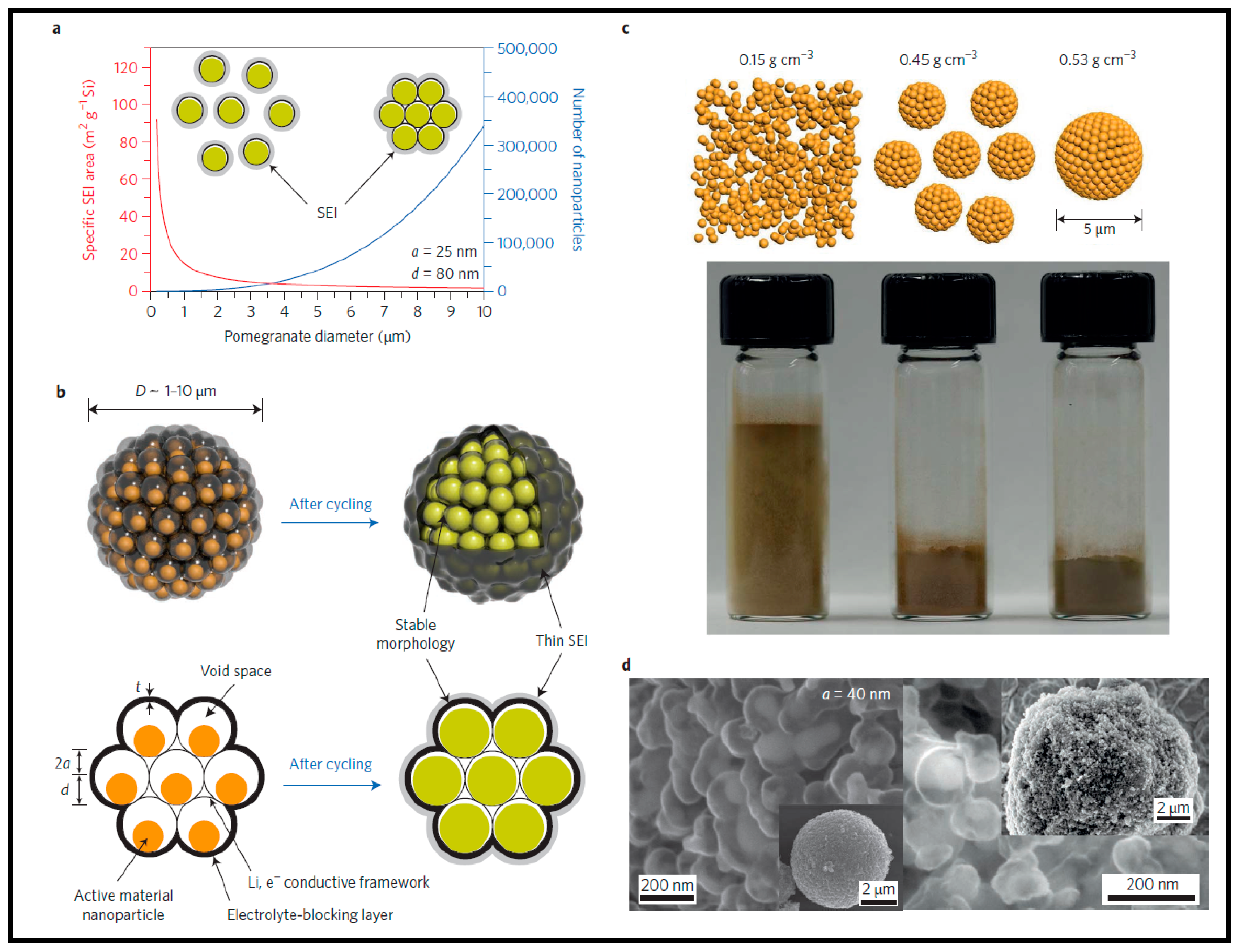
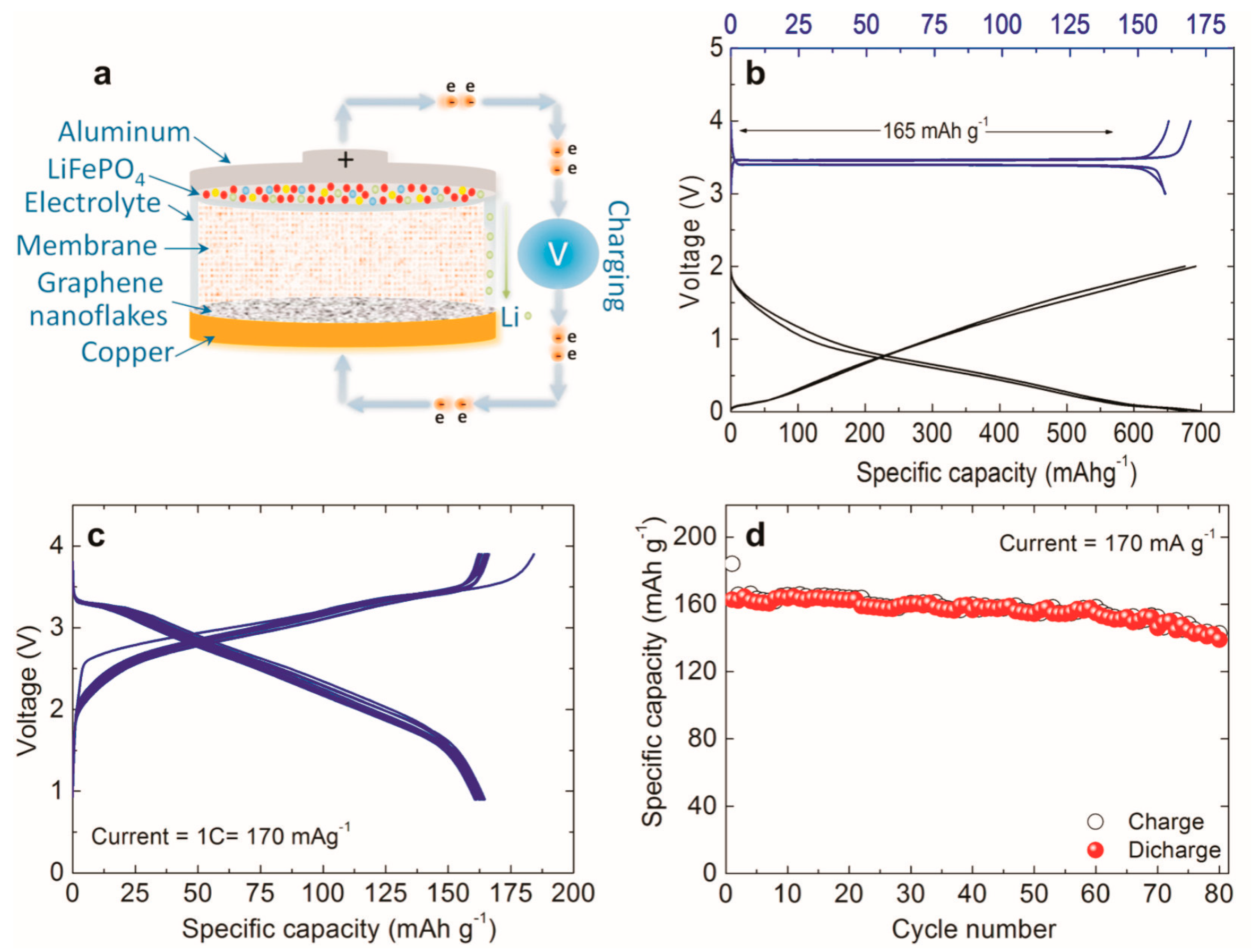
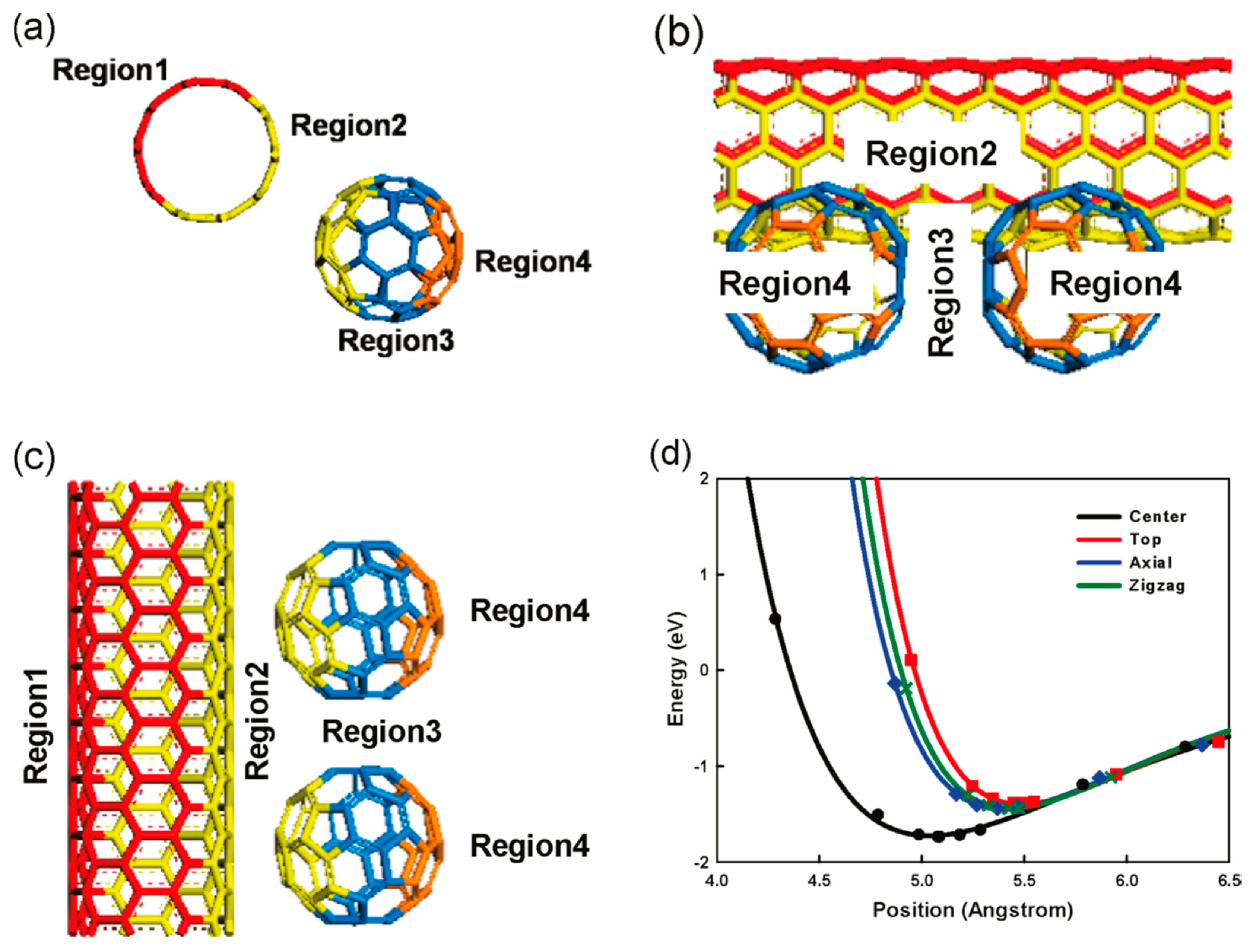
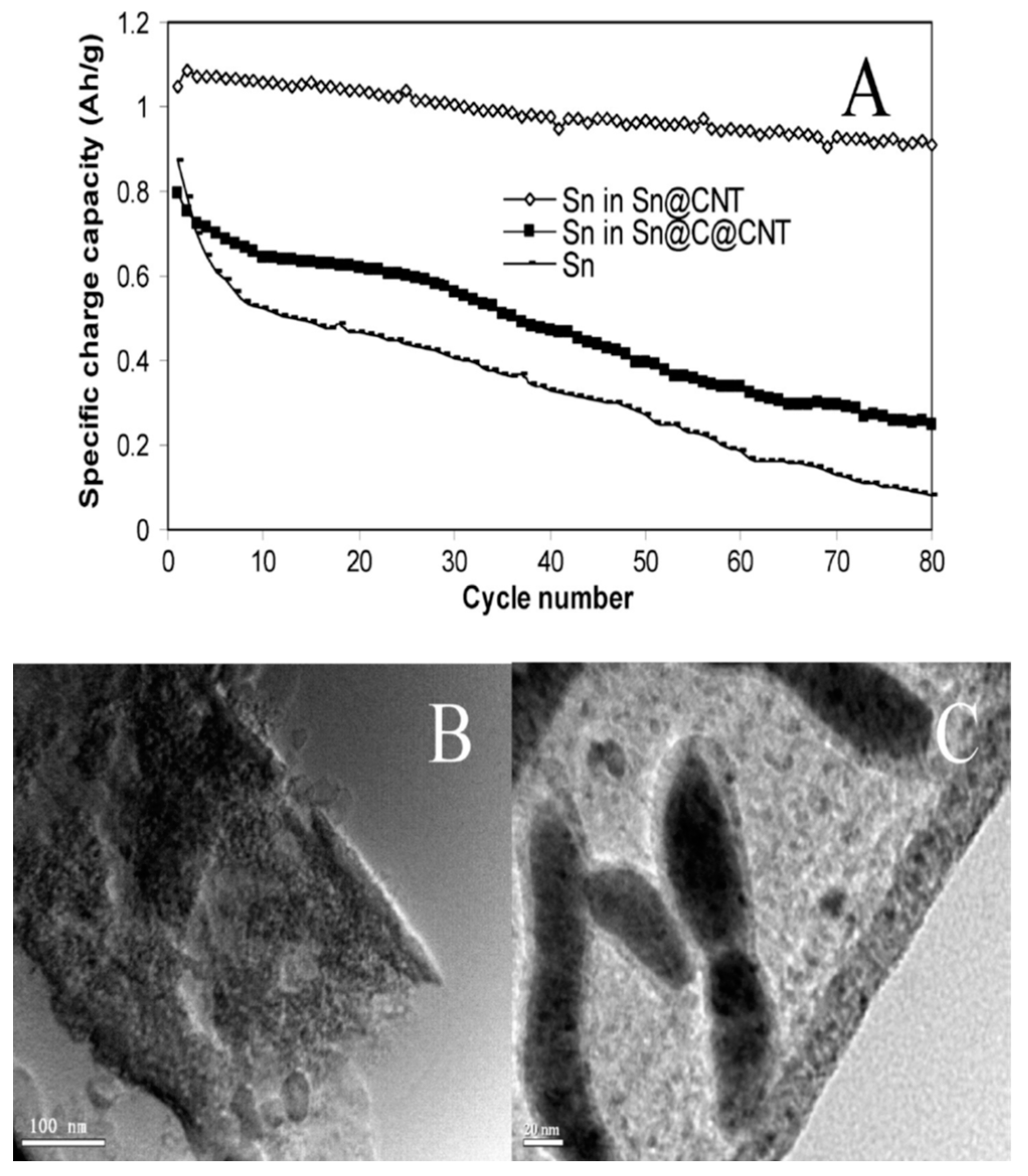
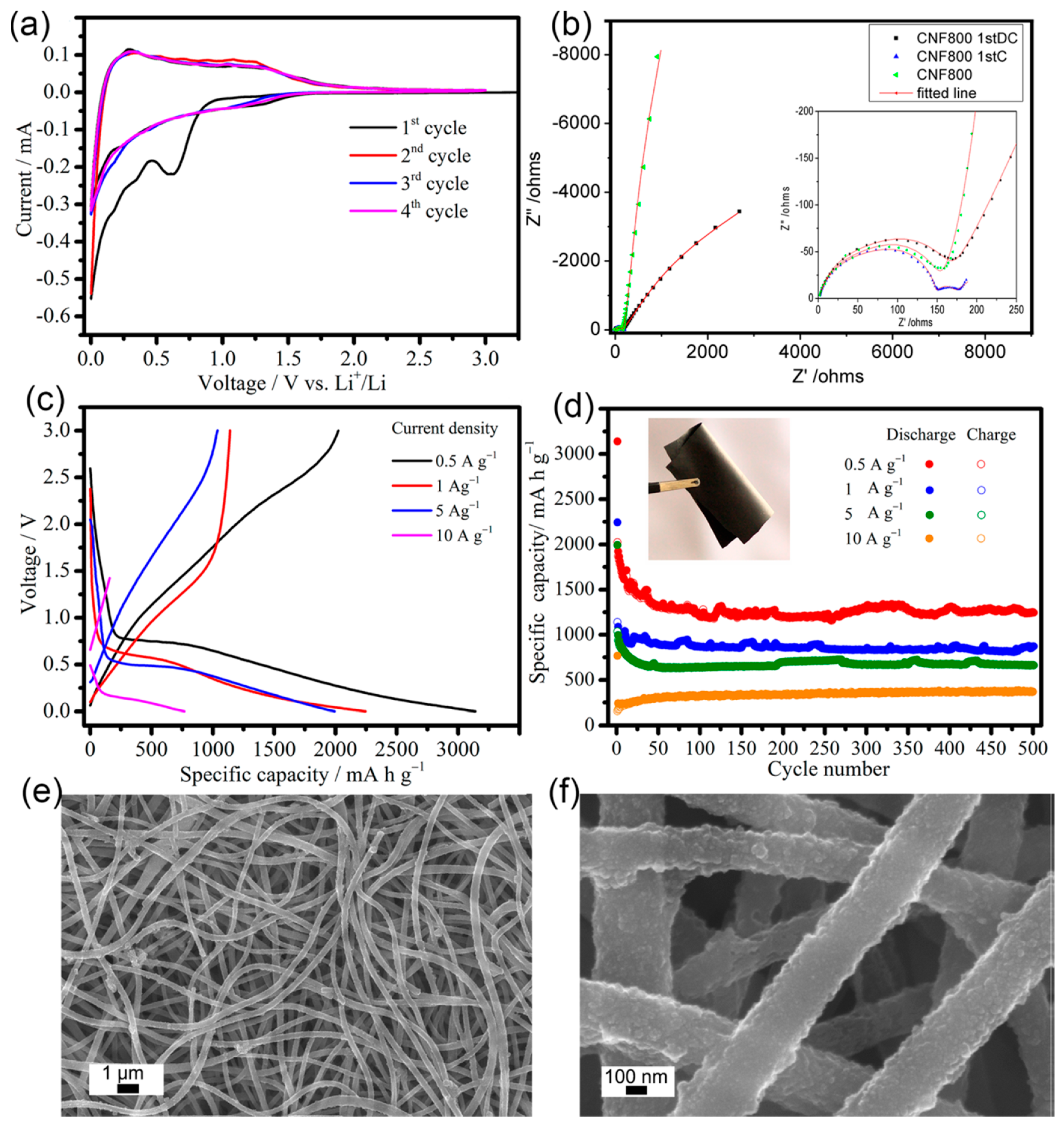
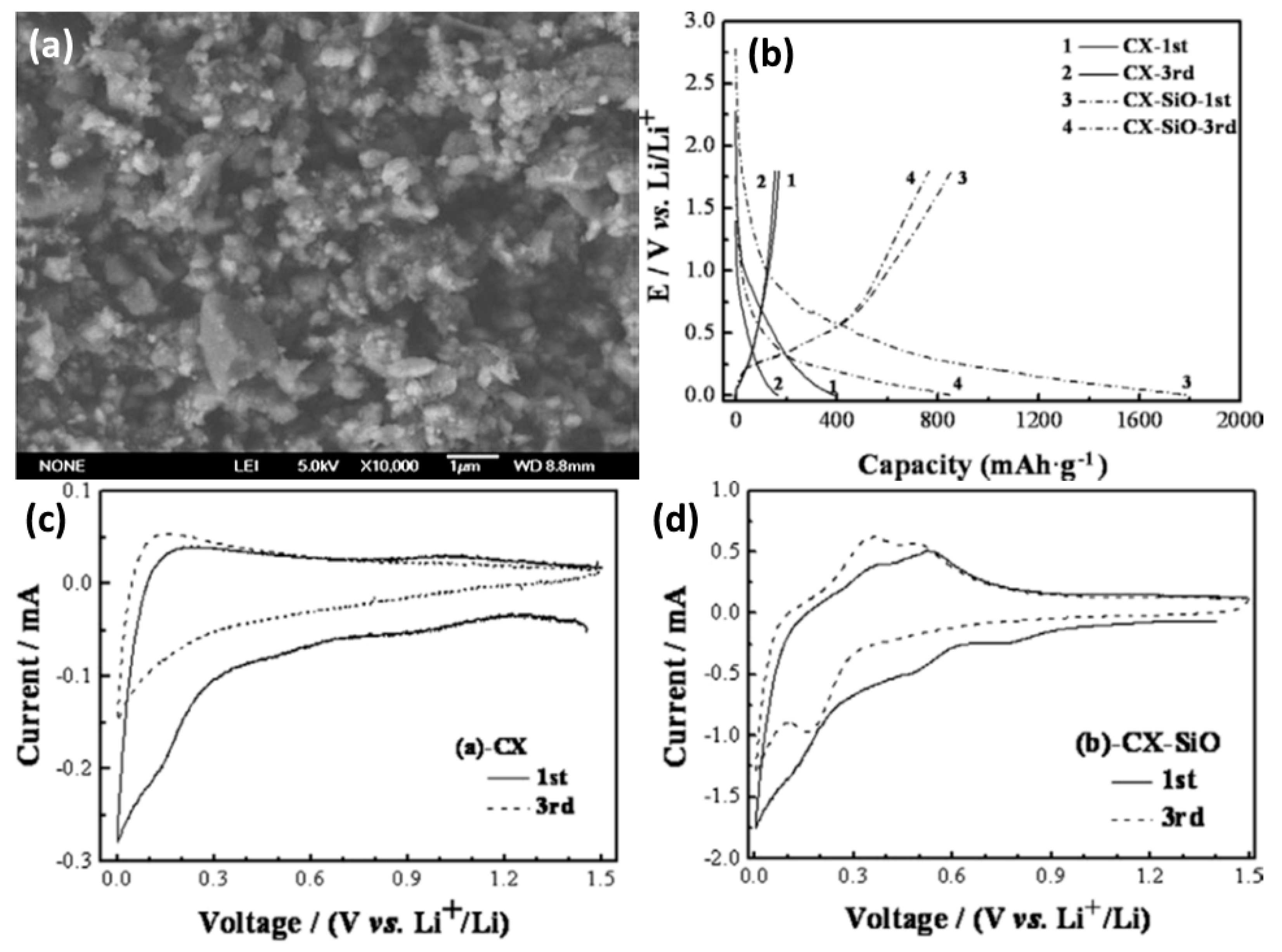
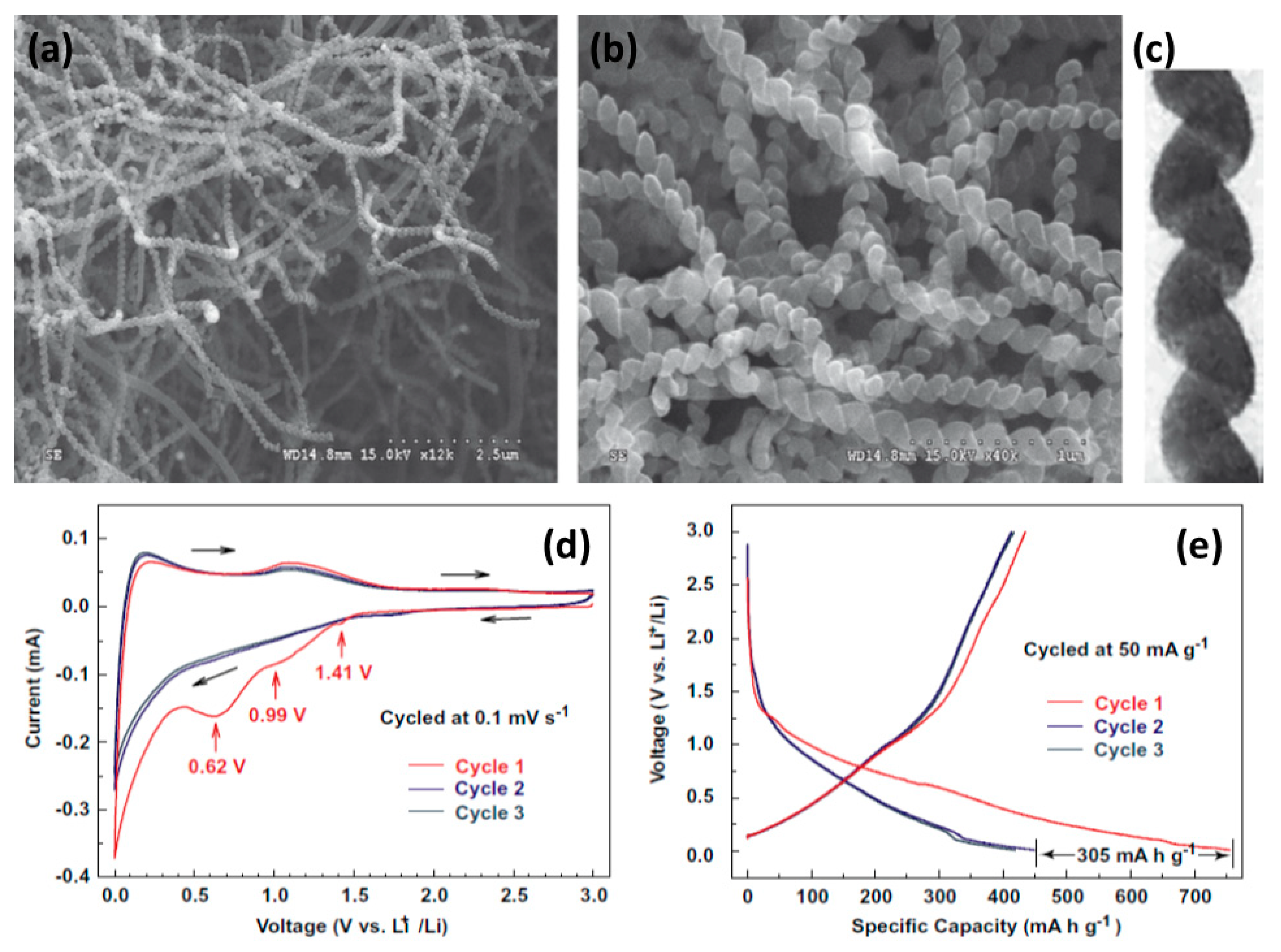
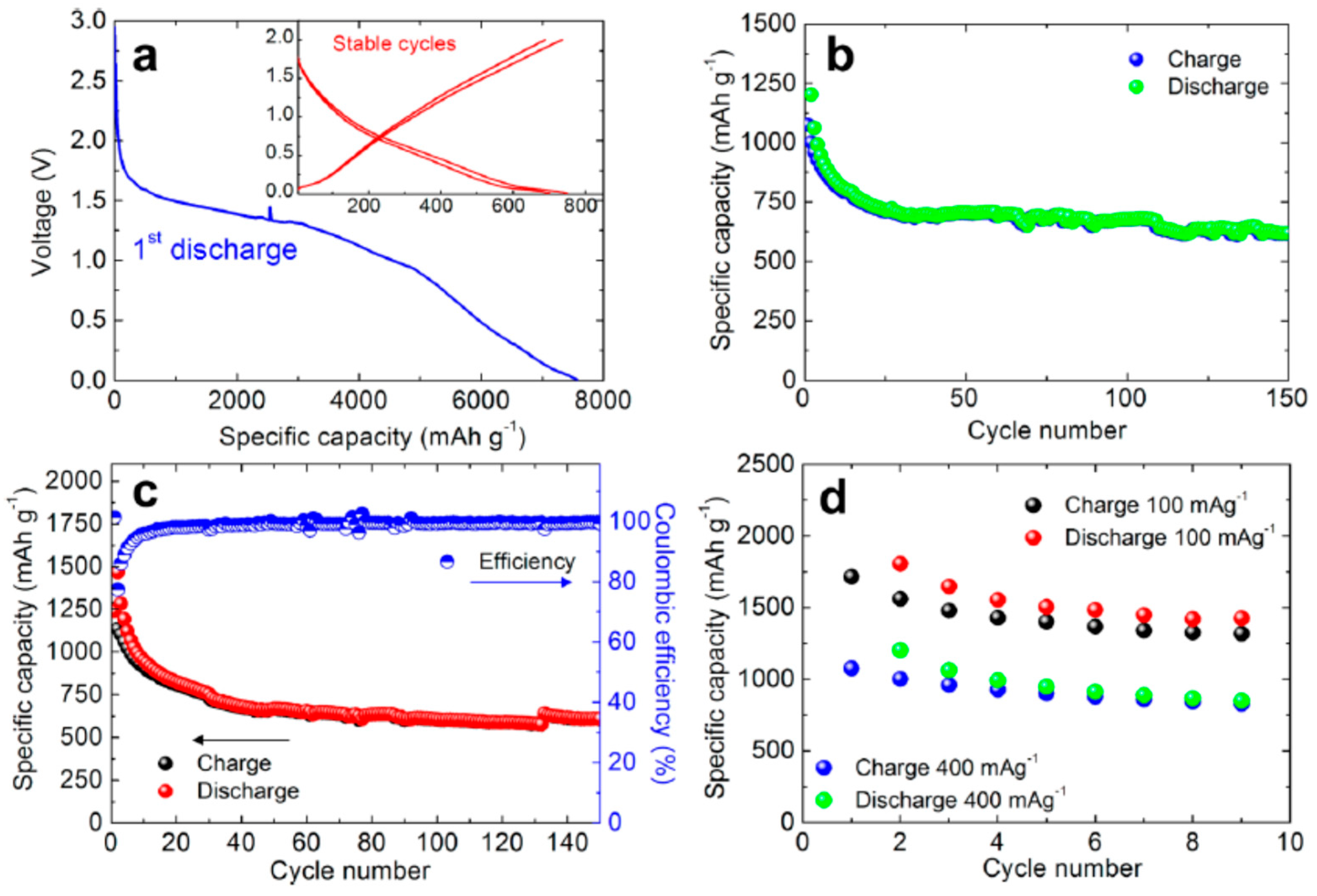
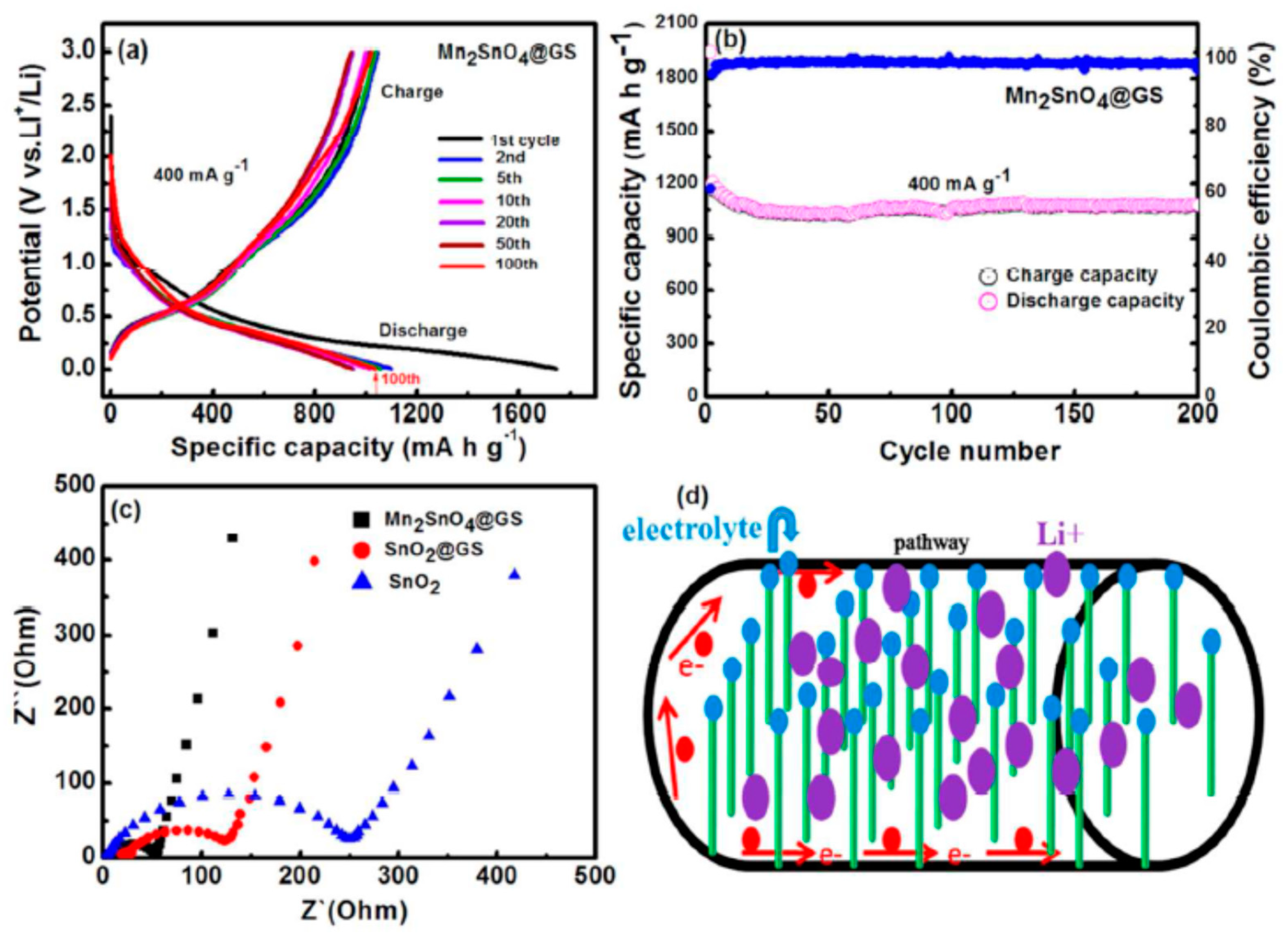
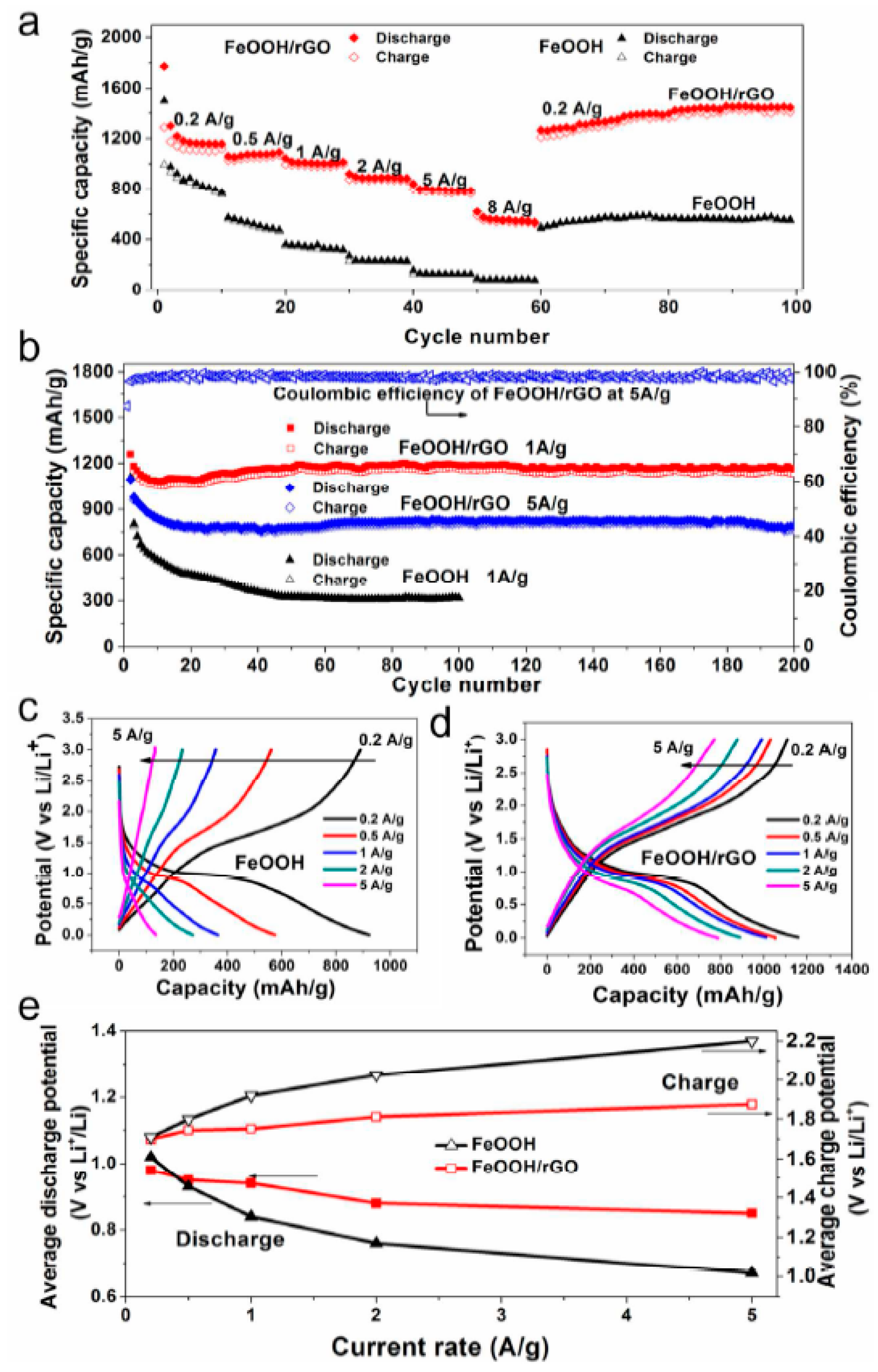
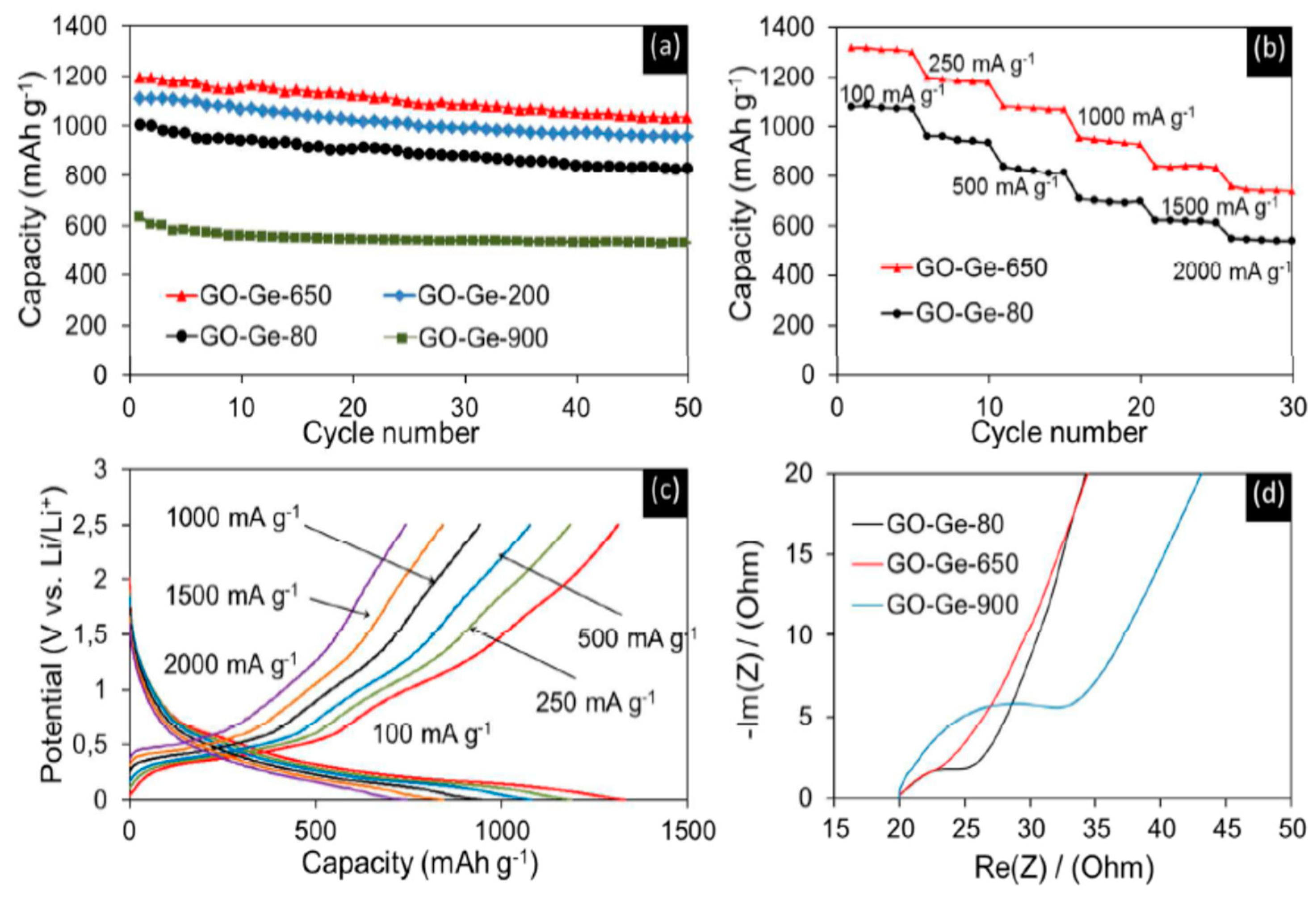
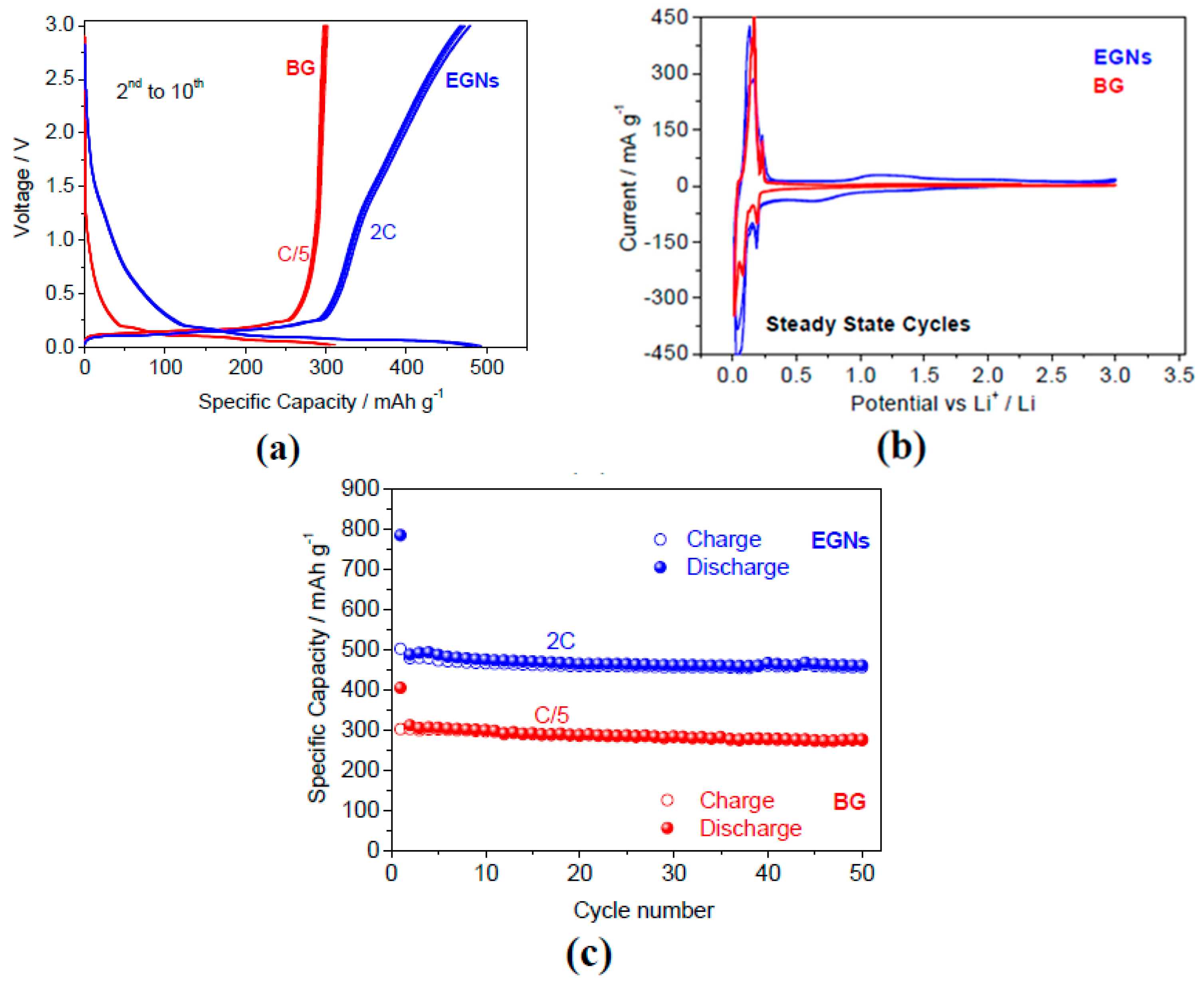
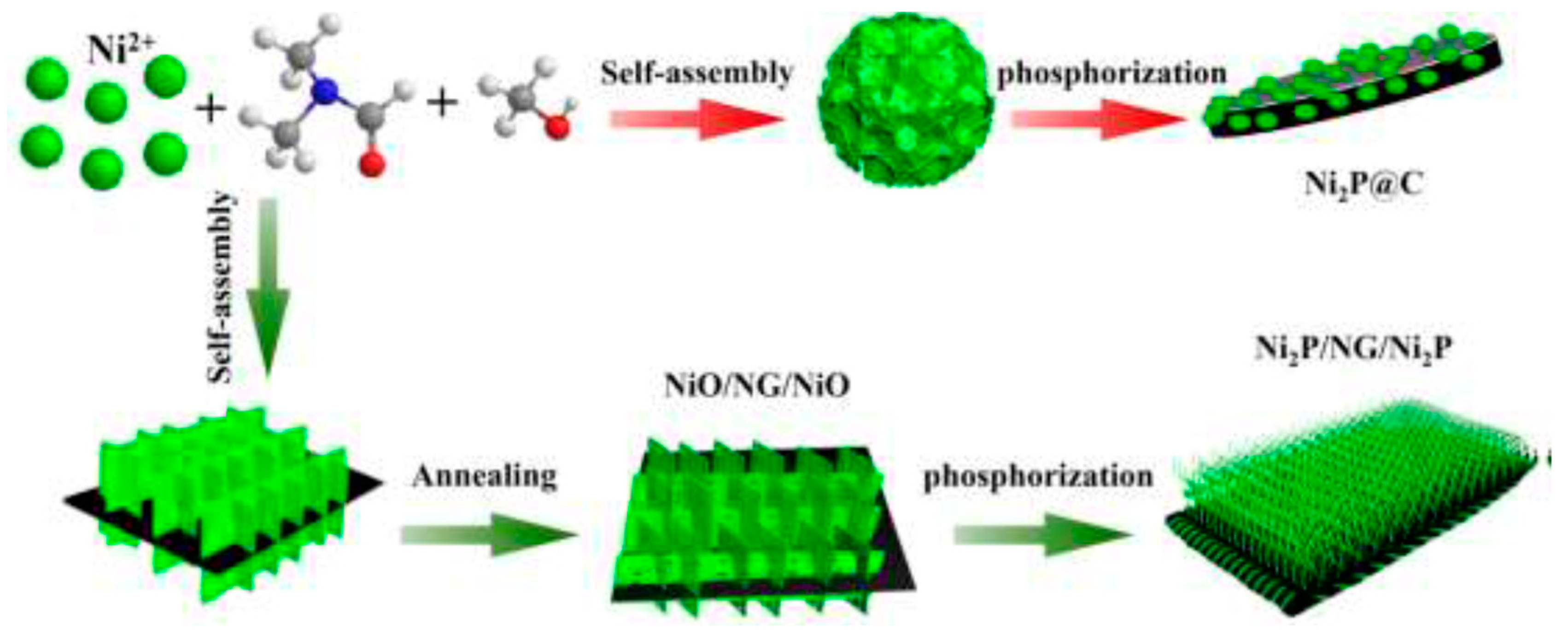
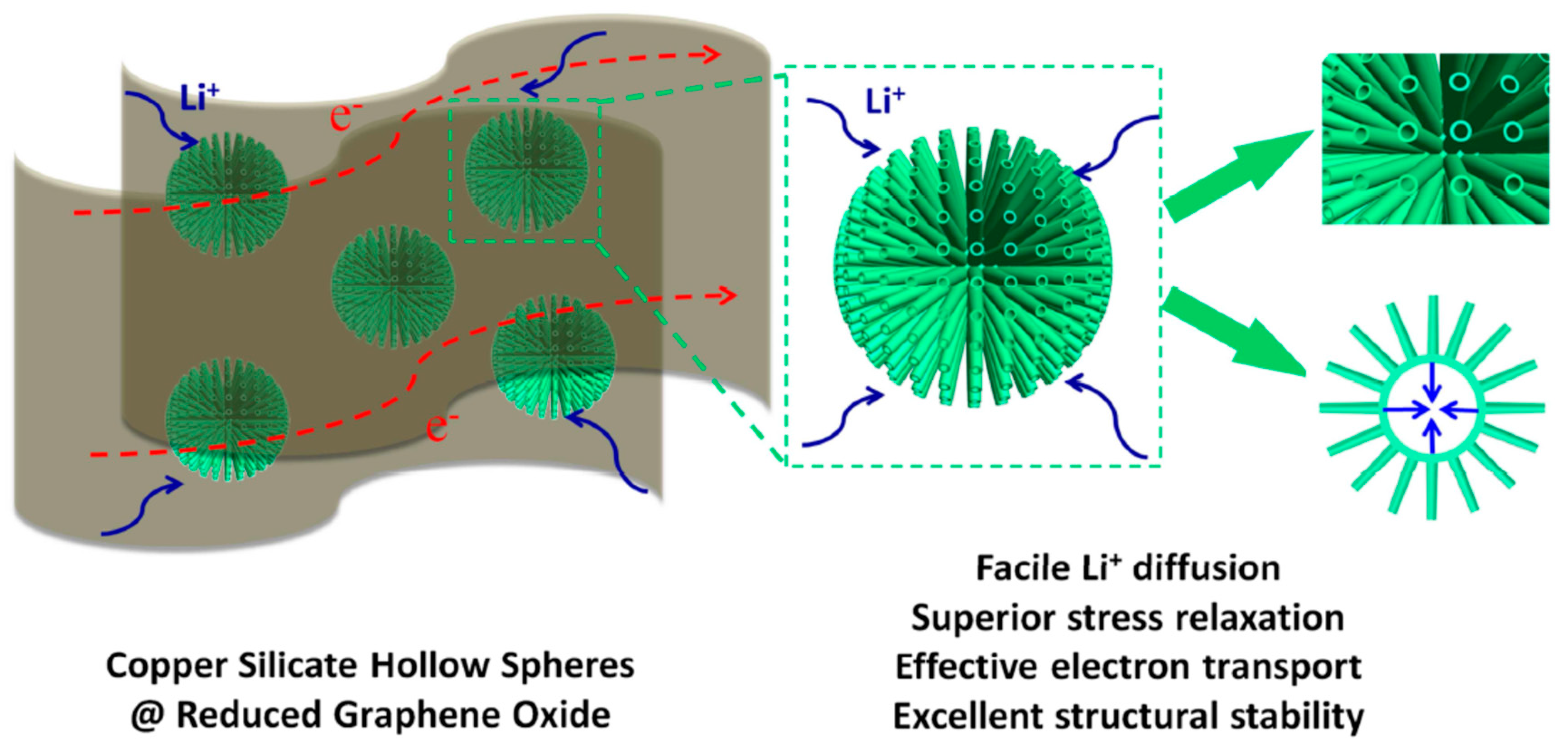
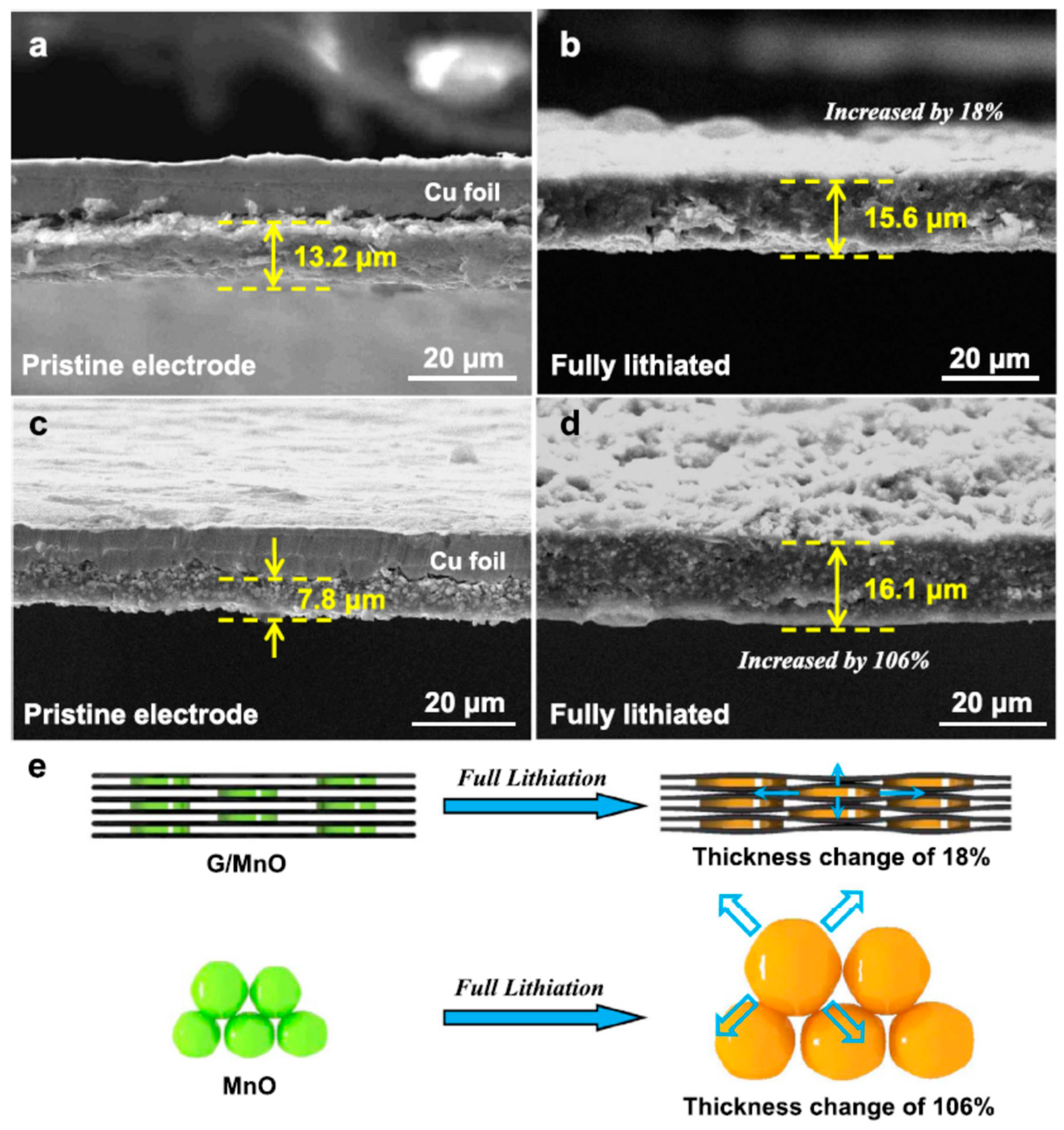
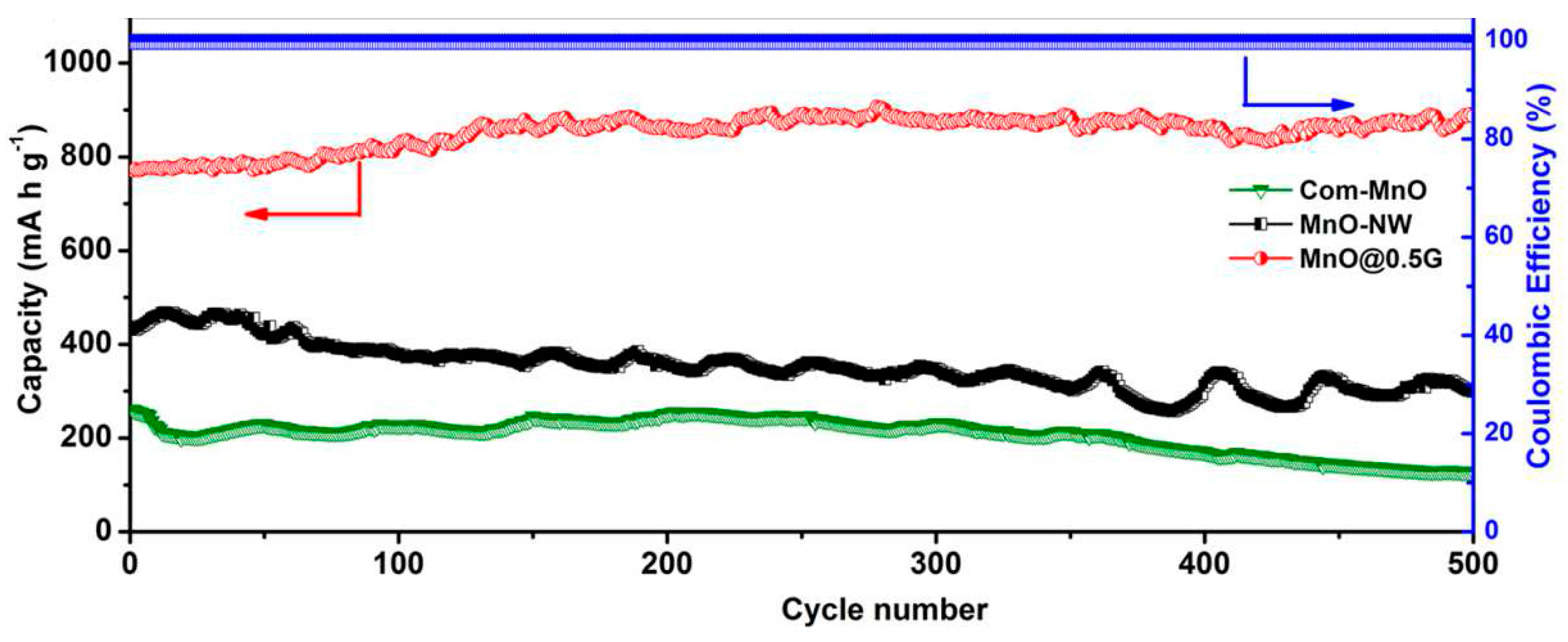
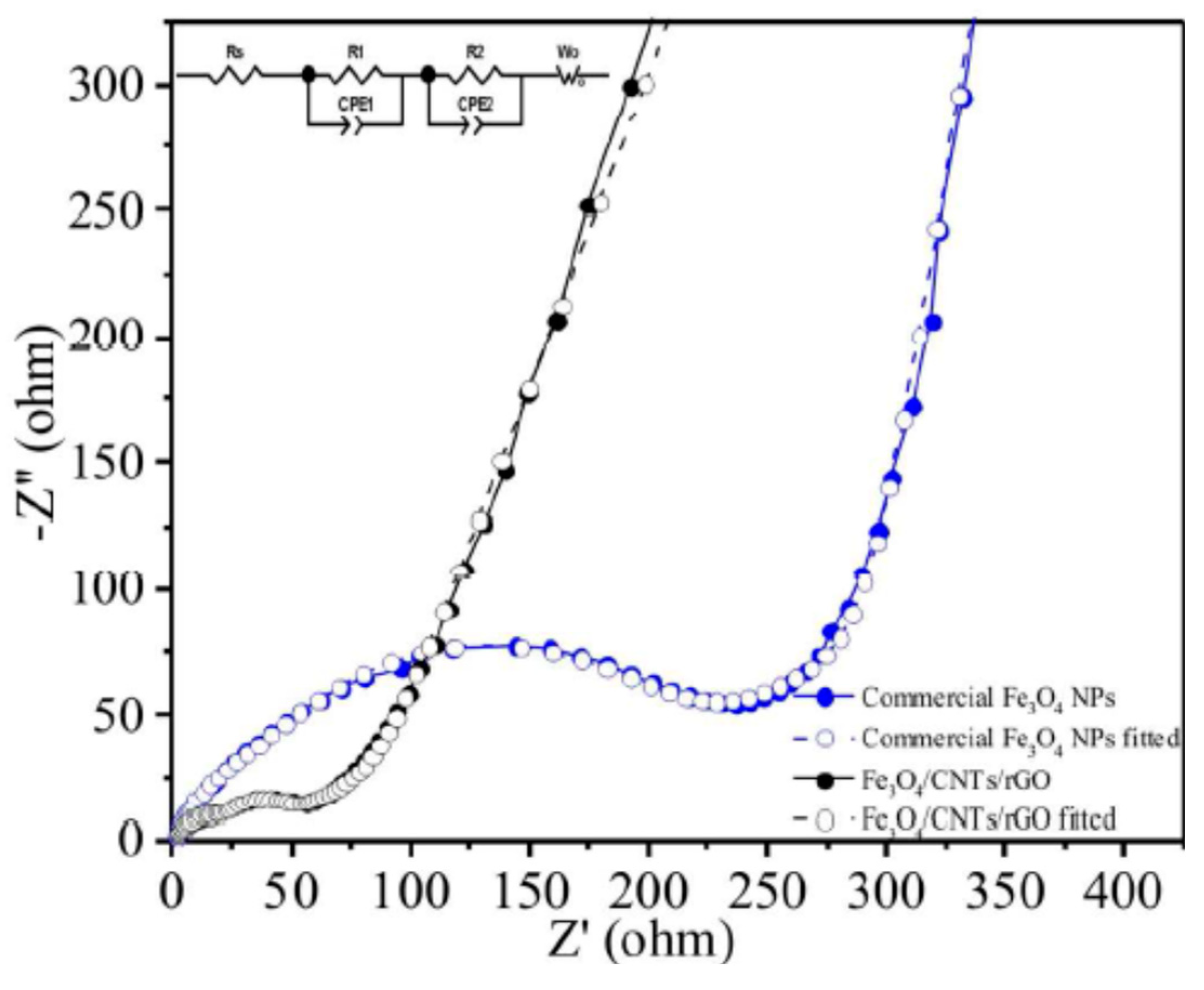
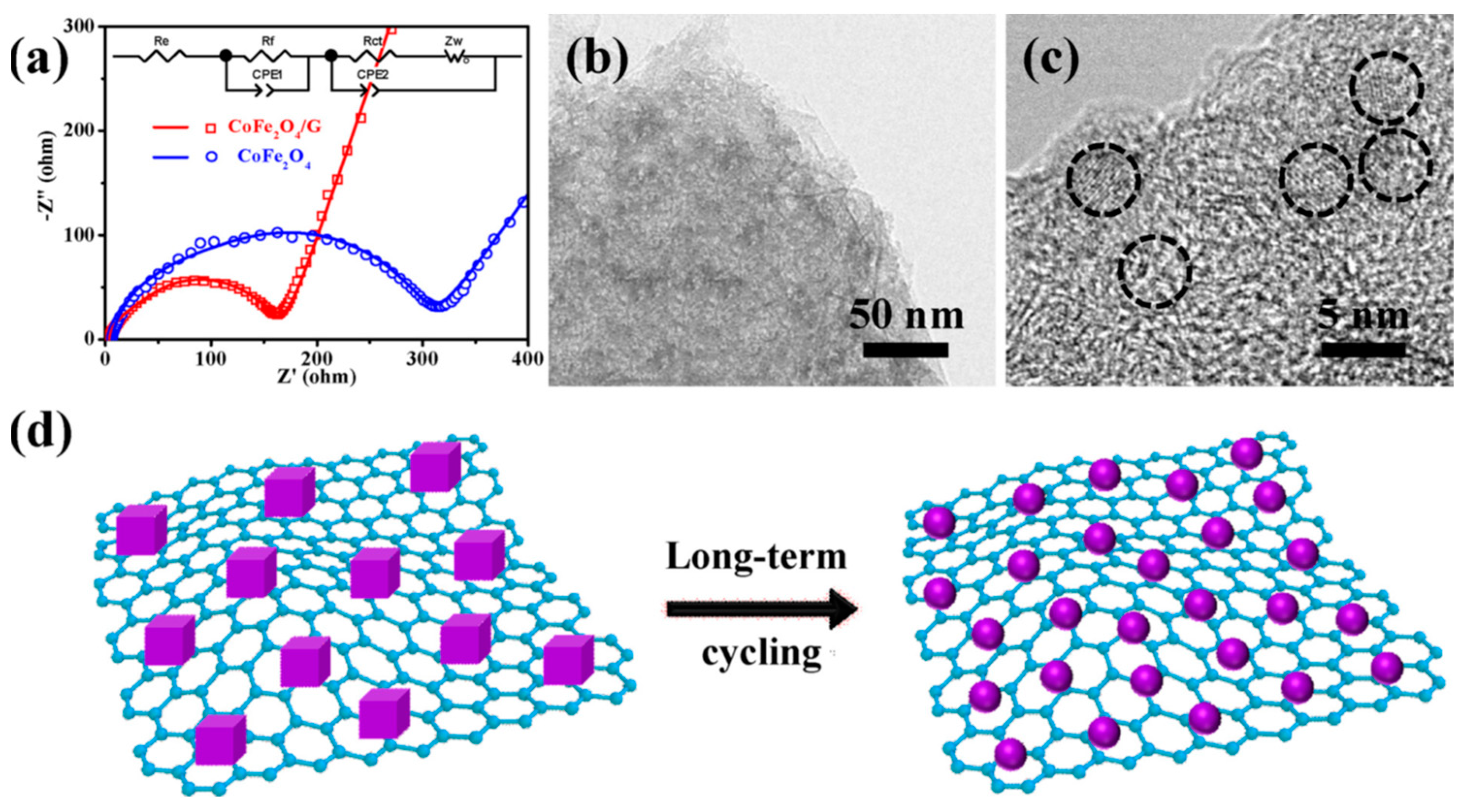
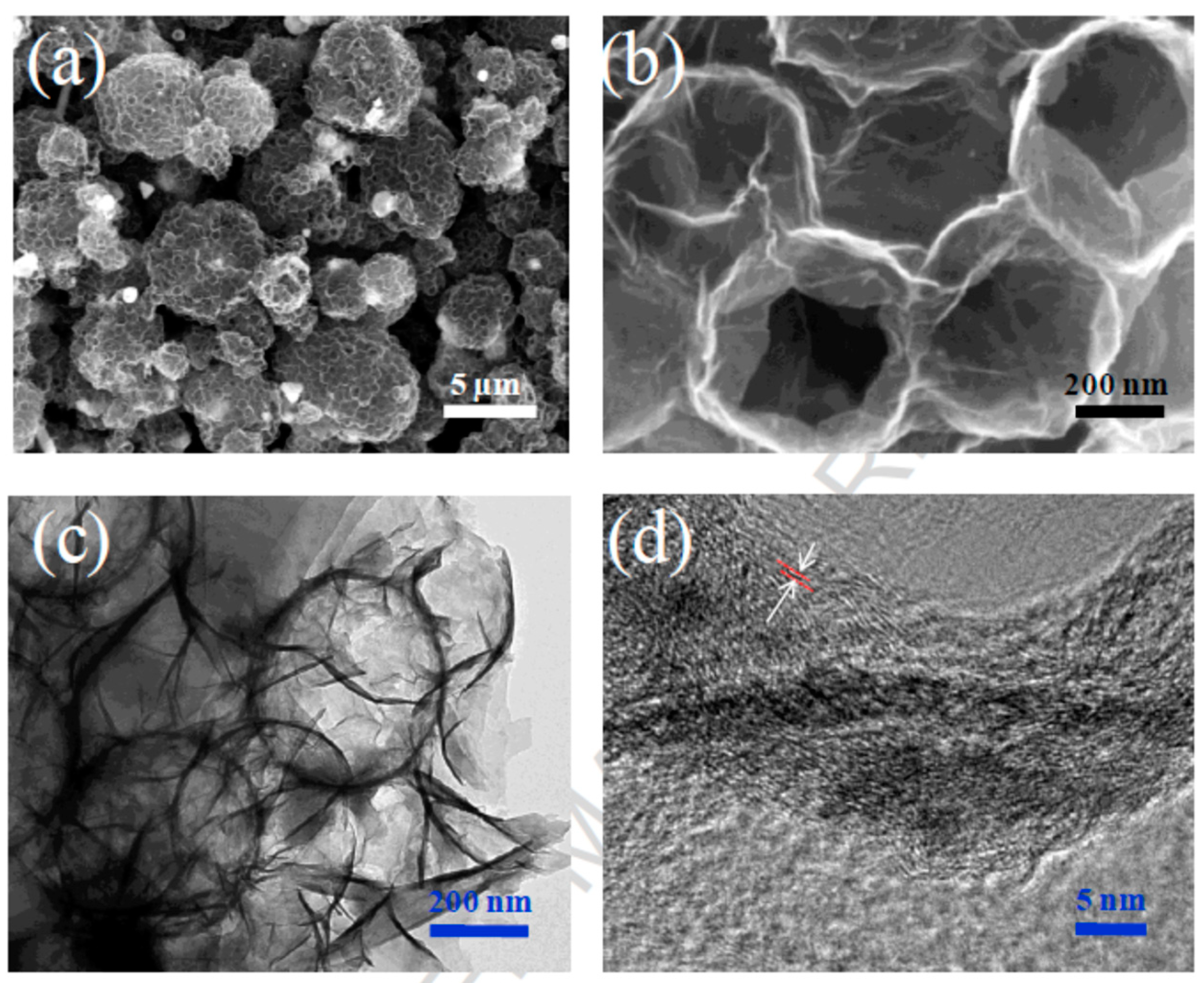
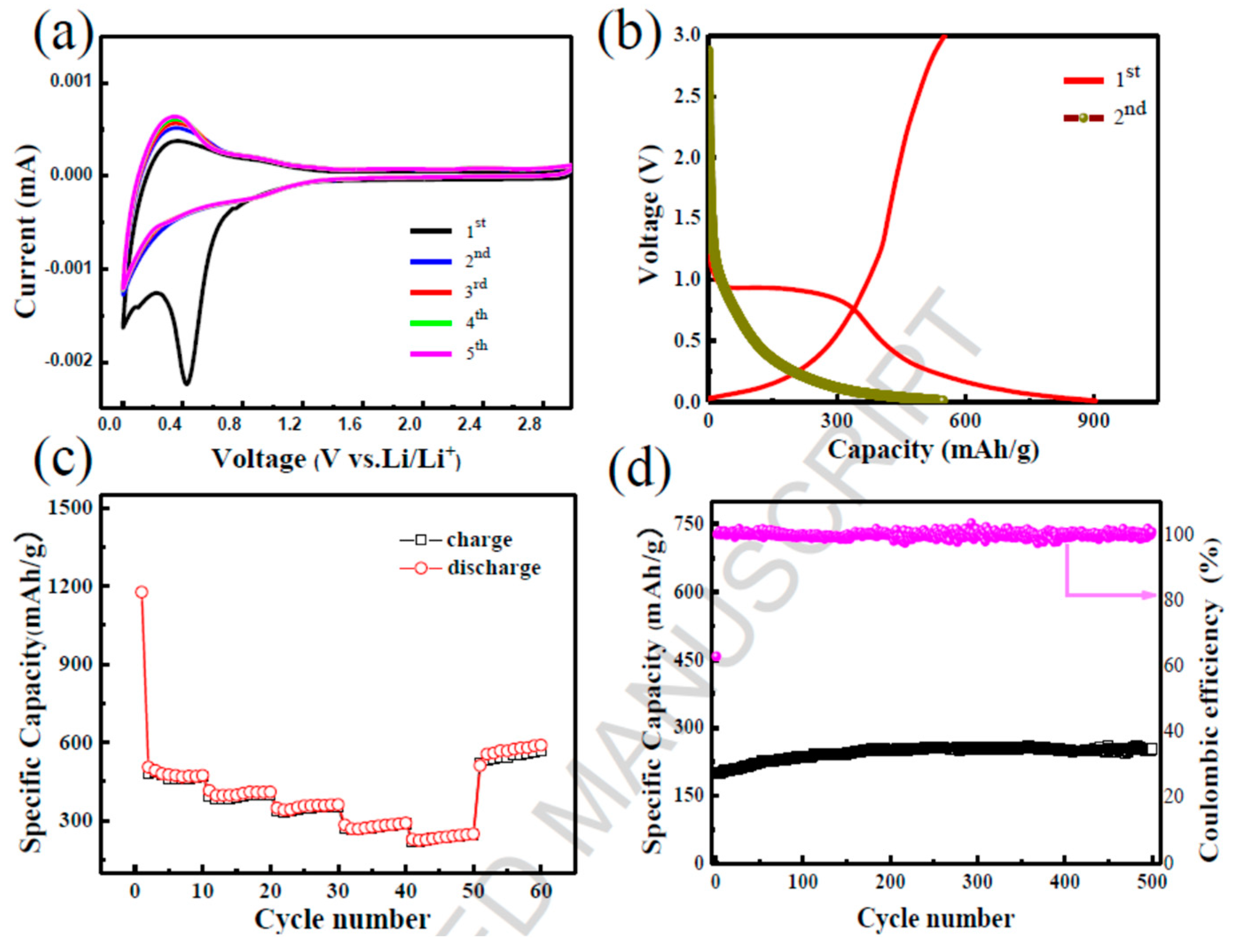
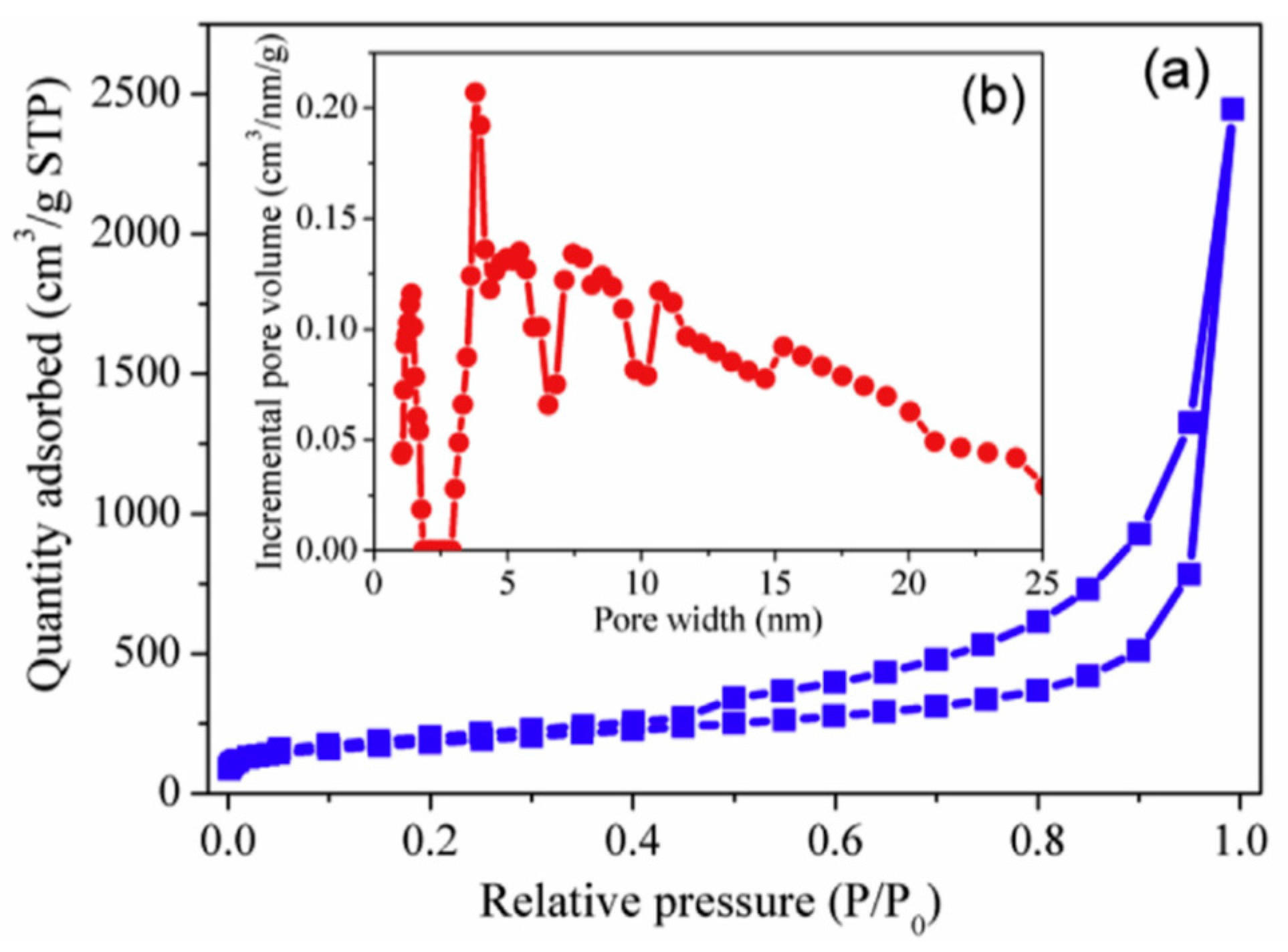
| Sample | SnO2 | SnO2/RGO | FTO | FTO/RGO |
|---|---|---|---|---|
| 1st discharge capacity (mAh g−1) | 787 | 1536 | 1168 | 2108 |
| 200th discharge capacity (mAh g−1) | 201 | 821 | 265 | 1439 |
| Capacity retention after 200th | 26% | 53% | 23% | 68% |
| Materials | Significant Applications/Findings observed | Ref. |
|---|---|---|
| ZnCo2O4/ rGO | The electrochemical properties of ZnCO2O4/rGO composite material exhibited a raised cycling capability as high as 1613 mAh g−1 at 500 mA g−1 over 400 cycles | [228] |
| Sn@ G | The 3D hybrid Sn@Graphene anode displays an elevated cycling capability of 1022 mAh/g at 0.2 C and 270 mAh/g at 10 C along with tremendously longer cycling stability at higher rates, such as 682 mAh/g cycling stability at 2 A/g. This is roughly about 96.3% even after 1000 cycles, which is perhaps the best rate capacity and lengthiest cycle life ever testified for Sn-based battery anode for Li ions. | [229] |
| Ga2O3/rGO | The Ga2O3/rGO nanocomposite has been proven to be a promising electrode material for use as a Li-ion anode with superior performance. This enhancement in performance is due to the electron transport characteristics created due to the presence of controlled open porous, crystal structure, and crystal morphology by doping with rGO. | [230] |
| GeO/GO | A test carried to evaluate the performance of different materials for lithium ion battery anodes revealed GO containing only 51% wt germanium to exhibit good storage capacity > 1000 mAh g−1 at 250 mA g−1. | [168] |
| Graphene-like graphite (GLG) | GLG’s discharge capacity above 1 V increases the oxygen percentage, with successive discharge capacity reaching 673 mAh g−1. Thus, GLG can act as an ideal anode for Li-ion storage cells. | [231] |
| Co3Sn2@ Co-NG | The Co3Sn2@Co-NG hybrid nanocomposite shows an unexpected reversible capacity of 1615 mAh/g at 250 mA/g after 100 cycles when used as an anode. These Co3Sn2@Co-NG composites were able to produce 100% coulombic efficiency. | [232] |
| CuMn2O4/G | These nanostructured CuMn2O4/graphene composites were able to deliver a larger capacity of 935 mAh/g after 150 cycles, corresponding to a current density of 50 mA/g. Additionally, it was further confirmed that CuMn2O4 composite changes into a nanosized CuO–MnO composite material with a spongy porous structure during discharge–charge processes. | [233] |
| ZnO/rGO | ZnO/rGO as an anode material in a lithium-ion battery exhibits brilliant cycling stability and improved charge capacity rates, because of its doughnut-like ZnO assembly. ZnO/rGO nanocomposite provides high electrical conductivity due to its short diffusion length. | [234] |
| Sn/SnO2@Graphene | Improved initial capacity as high as 2970.3 mAh g−1 makes Sn/SnO2@Graphene composites an ideal candidate for high-performance electrodes for Li/Na-ion batteries. | [235] |
| Co3O4/rGO | Co3O4/rGO composites are preferred materials for lithium ion batteries due to their superior electrochemical behavior as an anode material. This superior behaviour is as a result of the steady changes in morphology that occur with respect to thicknesses of the material during the process of cycling, thereby reducing the stress caused during cycling by providing a smaller diffusion path length for Li-ions and electrons. | [236] |
| 3DG/Fe2O3 | The 3DG/Fe2O3-based aerogel, when used as anode material for lithium-ion battery, displayed an extremely large storage capacity of 1129 mAh/g at 0.2 A/g after 130 cycles. This highly flexible anode retained a storage capacity as high as 98% after 1200 cycles at 5 A/g. | [237] |
| Graphene-Si aerogels | Electrochemical investigations indicated that the fabricated graphene–Si aerogels were capable of delivering 104% charging capacity at 0.8 A/g. Carbon nanotubes functionalized with silicon were utilized to achieve capacities as high as 1415 mAh/g at a discharge rate of 0.05 C. Thus, it is expected that graphene–Si aerogels will play a noteworthy role in lithium ion batteries. | [238] |
| Graphene nanoflakes ink | By optimizing the cell composition, the best battery behaviour of 165 mAh g−1 was achieved, corresponding to an energy density as high as 190 Wh kg−1 for an average of 80 cycles. | [74] |
| TiO2-B-G | TiO2-B-graphene nanocomposite material doped with 18.8 wt% of graphene exhibits promising electrochemical characteristics with charge capacities reaching 264 and 255 mA hg−1 at a current rate of 1 C. The storage capacity is as high as 171 mAh g−1 and was retained after 100 cycles at 5 C. The increase in graphene concentration above 27.7 wt%, diminished the lithium storage properties due to the accumulation of graphene structures. | [239] |
| Fe2N@AC@rGO | The amorphous carbon (AC) shell and graphene oxide (rGO) network were able to provide long-term cyclic stability along with extraordinary rate capability of 303 mAh g−1 at 10 A g−1. | [240] |
© 2019 by the authors. Licensee MDPI, Basel, Switzerland. This article is an open access article distributed under the terms and conditions of the Creative Commons Attribution (CC BY) license (http://creativecommons.org/licenses/by/4.0/).
Share and Cite
Roselin, L.S.; Juang, R.-S.; Hsieh, C.-T.; Sagadevan, S.; Umar, A.; Selvin, R.; Hegazy, H.H. Recent Advances and Perspectives of Carbon-Based Nanostructures as Anode Materials for Li-ion Batteries. Materials 2019, 12, 1229. https://doi.org/10.3390/ma12081229
Roselin LS, Juang R-S, Hsieh C-T, Sagadevan S, Umar A, Selvin R, Hegazy HH. Recent Advances and Perspectives of Carbon-Based Nanostructures as Anode Materials for Li-ion Batteries. Materials. 2019; 12(8):1229. https://doi.org/10.3390/ma12081229
Chicago/Turabian StyleRoselin, L. Selva, Ruey-Shin Juang, Chien-Te Hsieh, Suresh Sagadevan, Ahmad Umar, Rosilda Selvin, and Hosameldin H. Hegazy. 2019. "Recent Advances and Perspectives of Carbon-Based Nanostructures as Anode Materials for Li-ion Batteries" Materials 12, no. 8: 1229. https://doi.org/10.3390/ma12081229
APA StyleRoselin, L. S., Juang, R.-S., Hsieh, C.-T., Sagadevan, S., Umar, A., Selvin, R., & Hegazy, H. H. (2019). Recent Advances and Perspectives of Carbon-Based Nanostructures as Anode Materials for Li-ion Batteries. Materials, 12(8), 1229. https://doi.org/10.3390/ma12081229









